

PLANET EARTH TRAVELS
1.6 MILLION MILES EVERY DAY.



PLANET EARTH TRAVELS
1.6 MILLION MILES EVERY DAY.
4 of North America’s Top 10 Fifth Wheel RV brands are manufactured by Keystone. (And our newest just won RV of the Year.)
 Luxury fifth wheel RVs that deliver more value, performance and delight. Now equipped with SolarFlex™. Meet Montana, Alpine & Avalanche, Cougar, Sprinter and Arcadia at KeystoneRV.com/fifthwheel.
Luxury fifth wheel RVs that deliver more value, performance and delight. Now equipped with SolarFlex™. Meet Montana, Alpine & Avalanche, Cougar, Sprinter and Arcadia at KeystoneRV.com/fifthwheel.

20 Go Big or Go Home, or Both
This family travels full time in a semi-truck RV.
23 A NewlywedFriendly Renovation
You don’t have to spend a lot of money to build a home.

25 Our Lives Changed Forever
A couple recovers from a devastating explosion in their truck camper.









Built to help you take on dirt, gravel, deep climbs and everything in between, the Lippert Li-Series Gladiator mountain ebike is versatile, tough and ready for every adventure. This is the perfect electric mountain bike for riders looking to explore off-road with more endurance and energy than ever.

59
Nova Scotia
Plan a road trip to this beautiful Canadian province.

62
Great Smoky Mountains National Park
You’ll have plenty to do in America’s most visited national park!
68
Joshua Tree National Park
Only have the weekend? Check out this one-day itinerary.



WE ARE CALLING this the Renovation Issue, and inside, you’ll find lots of inspiration to plan or begin your RV renovation. Let me start with our own story about renovating our RV.

Like so many full-time, part-time, or sometime RVers, we are always trying to find ways to make our RV fit our needs best, and in late 2020, Nikki and I decided to completely gut and renovate the RV. We had two main motivations. First, we wanted actual desks and dedicated office spaces—no more sitting at the dinette table. Second, we wanted to make the RV look and feel more like a home. It always felt really strange when we would meet people who had the exact same RV as us and notice our interiors were exactly the same. It felt like someone was in our house!
The hardest part about renovating a “new” RV is deciding when to start the process. Do you use it as it is for a while, or do you gut it and make it your own on day one? Buying used gives you a great excuse to gut and renovate, but when everything is brand new, it can be hard to justify.

Ultimately, I’m glad we decided to wait a few years and really figure out what would work best for us and what we needed and didn’t need. Plus, we were able to get the most out of the interior that came with the RV.
Nikki and I had no renovation experience, and even though we had to ask for help and guidance along the way (and watch lots of YouTube videos), we learned so much and are excited to renovate another RV down the road. But for now, our RV is exactly the way we want it, and it really feels and functions like a home and office on wheels.
We would love to showcase an RV renovation in every issue, so if you’ve renovated your RV or know someone who has, please let us know by emailing us at collab@rootlessliving.com. Let’s inspire people to make their RV fit their lifestyle.

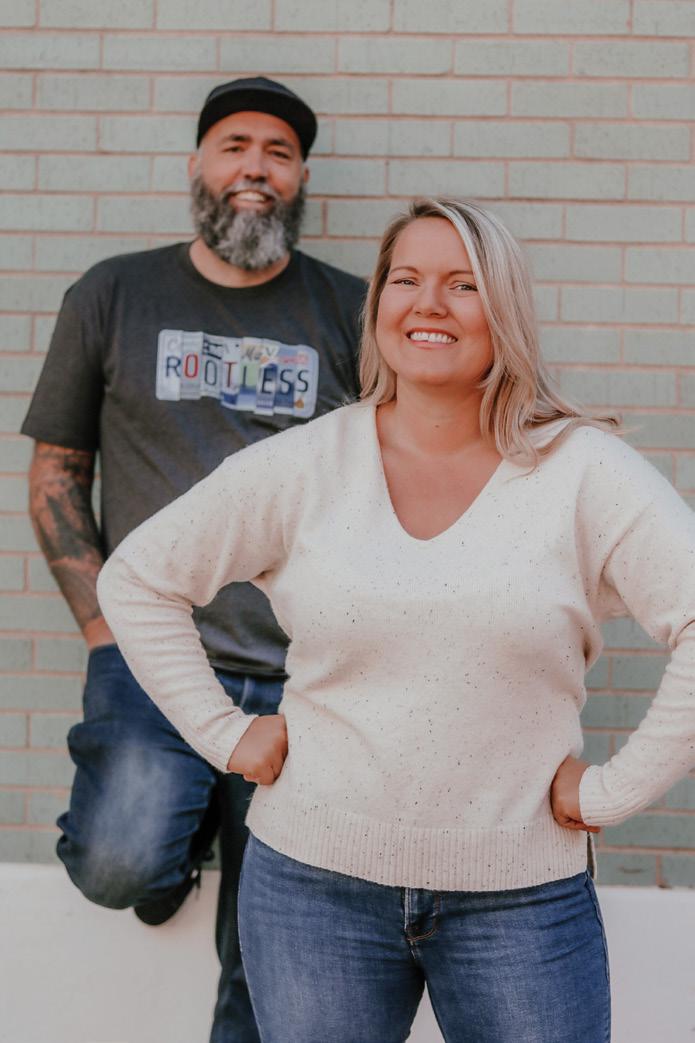
Until the next issue … stay Rootless.
Demian Ross, Publisher @demianross demian@rootlessliving.com Nikki Kirk, Chief Editor @nikkirk7 nikki@rootlessliving.com
Nikki Kirk, Chief Editor @nikkirk7 nikki@rootlessliving.com
Publisher Demian Ross
Chief Editor Nikki Kirk
Managing Editor Jess Stiles
Editorial Assistant L. Merredith


Art Director Melinda Gonzalez
Operations Manager Jamie May
Copy Editor Kristin Skaggs
Advertising Information: sales@rootlessliving.com







ROOTLESS LIVING MAGAZINE PO Box 437, Jennings, OK 74038

Disclaimer: One of the great things about digital publications is the ability to link you directly to the products or services you want to hear more about. Some of the links in this issue are affiliate links where we earn commissions on goods or services you buy. These commissions help us to continue to publish the magazine. Rootless Living is also a participant in the Amazon Services LLC Associates Program, an affiliate advertising program designed to provide a means for sites to earn advertising fees by advertising and linking to Amazon.com. If you have any questions please don’t hesitate to reach out to us at info@rootlessliving. com
Copyright © 2022 Blue Compass Media LLC. All Rights Reserved. Reproduction in whole or in part without written permission is prohibited. No responsibility is assumed for unsolicited submissions.








Bill Sterling
Jacob and Grace Kocher
Grayson and Ashleigh Levy
Jay McCormick
Cortni Armstrong
Jac Curtis
Marissa Moss
Jeff Roby
Jamie May
Brooklyn Durell
Carrie Shoemaker
Ashley Warren
Ashley Peeples
Lisa Paulos
Cara Hefty
Margaret Dee
Derek King
Hillary and David Monsour
Kerisa and Anthony Tiongson
Jamie Rea
Pam Pederson
Stephanie and Jason Miller
Carla Geyer
Diana Ditkof
Amanda Boles
Lacey Reichwald
Beth Cronin
JoAnn Anderson
Jesseca Perry
Sarah Gibbons
Lauren and Jon Gusanders
Want to be a part of the next issue? Reach out to us at collab@rootlessliving.com
KAETLYNN DAOUST
@girlandhusky
The Ultimate Life
One part dog mom, one part weekend warrior, and equal parts loud laugher and awkward dancer—meet Kaetlynn! She and her husky, Mako, primarily live in Arizona, exploring the desert by hiking, backpacking, and paddleboarding with friends. Kaetlynn is a professional ultimate frisbee player with the Arizona Sidewinders and enjoys drinking gluten-free beers while watching the sunset from her rooftop deck!
AMANDA SWANSON
@sparkfireswan
Working Wherever
Amanda, her fiance, Adam Tarras, and their two Bengal cats, Roscoe and Rahja, lived in a townhome in Woodbury, Minnesota, for almost a decade before making the choice to move full time into a 32-foot travel trailer. You can follow more of their journey on Amanda’s blog, sparkfireswan.com
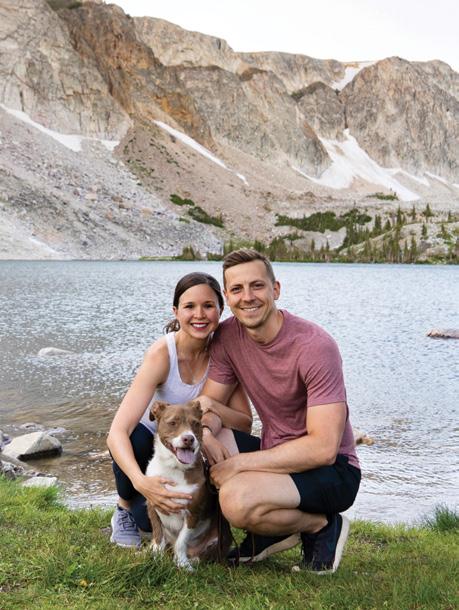
KATHRYN NOLASCO
@hometrippin
Go Big or Go Home Or Both
Kathryn is a wife, homeschooling mom of two, and creative business owner who shares about chasing big dreams, putting more life into our years, and what it’s really like to work, live, and play in a tiny home on wheels. You can follow her latest on Instagram or on her website at kathrynnolasco.com



ADAM AND KATHRYN FRAZER
@adventuresofaplusk
Joshua Tree National Park
Adam, Kathryn, and Kona are an adventurous married couple and their pup living on the road in their self-converted sprinter van! Find them driving all over scoping out the best coffee shops, eating tacos and ice cream, and enjoying nature. For their detailed travel guides, check out adventuresofaplusk.com and their YouTube channel, Adventures of A+K



“A house with many windows is a must for us, and a school bus checks that box entirely. The sunlight meanders through our little home and seems to reach every nook and corner perfectly. Nothing beats walking into literal rays of light and feeling your soul shine.”
“Rob schools the two oldest, and I homeschool the little one. They enjoy music, dancing, art, hiking, and most of all, they LOVE making new friends and traveling.”

“As the whole canyon came to glisten in the sunrise, it was a gentle reminder to myself to hold steady in my own pace in life and to create my own beauty and intention.”

“Our new Fleetwood RV has twice as much space— Charlie’s not sure what to do! Now she can even fit in the bathroom with me! Her favorite—mine, not so much.”


MY 18-YEAR-OLD DAUGHTER, Lillian, and I are traveling the United States together. Lillian is a student, and I’m taking a break from the working world after about 25 years in the auto industry. Our home base was Florida, but now it’s the entire country.
Three years ago, the day before my father died, he told me I needed to get going if I was going to travel. “This is you in 25 years,” he said. None of us are getting any younger, but we often believe there will always be time and health. His urgency prompted me to take action and hit the road.
We are traveling with two vehicles. I’m driving a vintage
1973 Balboa motorhome, built by Jensen Marine in California. Lillian is driving a 1996 Chevy Beauville passenger van that has been lightly modified to suit her travel needs. She lovingly refers to it as her She Shed, and shares it with her three cats. The van also tows a small trailer carrying things such as spare fuel, tools, and extra water. Lillian’s van is nearly vintage at 26 years old, but compared to the 49 years on my Balboa, her van is considered the support vehicle.
The Balboa motorhome has sentimental significance to me. When visiting RV dealers back in the ’70s with my father, he always wanted a Balboa, partially because he loved the

extra-large side windows, which provide amazing views!

Jensen Marine was the builder of Cal Yachts, among others. The company wanted a higher-end, personal-sized RV for their existing market, and they created the Balboa Motorhome. Based in Costa Mesa, California, they sold an estimated 1,100 Balboas starting in 1969 until the 1974 fuel crisis caused the division’s demise. Despite the compact 18-foot overall length, the little camper has a full kitchen with dual sinks, an oven, and a four-burner stove. It also sports a full marine-style bathroom with a shower and flush toilet. As you might expect, much of the equipment used in the Balboa is carried over from Jensen’s marine division. With its compact size and common Chevy, Dodge, and Ford cargo van underpinnings, it was marketed to be a simple yet luxurious multi-purpose alternative to the station wagon. I’ve retained the ’70s vibe of the Balboa wherever possible.

After finding my motorhome in Idaho and traveling with Lillian to bring it back to Florida, I began renovating the RV and updating some of the older systems. For example, I needed to upgrade the electrical system with solar and a lithium house battery. Upholstery, flooring, and plumbing were also addressed. Mechanical systems were taken care of in Spokane, Washington, and Florida. Exterior cosmetic work was continuing right up to a few days before

departure. As I was told, “If you wait for everything to be ready, you’ll never leave!” Like any pet project, it will never really be complete, and some projects will be completed along the journey.
Lillian and I departed in the fall, and we had already logged more than 3,500 miles by mid-winter. Having plenty of time and a flexible schedule allows for side trips and exploring. We’ve traveled across the Southeast, learning about Civil War history while visiting Fort Gaines, Georgia, the civil rights movement in Alabama, and the rich history of New Orleans. In Dallas we saw the Sixth Floor Museum, and in San Antonio, the missions and the Alamo. Far West Texas destinations included Big Bend National Park, Marfa, and El Paso. Next on the list is more of the Southwest, California and the Pacific Coast Highway, and as the weather allows, the Pacific Northwest. There is so much to see!
Exploring the country in vintage equipment is not for the faint of heart. Aside from the usual challenges of the nomadic lifestyle, older vehicles require special care in order to stay on the road. Both the motorhome and the support van were extensively serviced before departure, and we’re being extra careful along the route, respecting that these vehicles have some years on them. Frequent inspections, gentle driving habits, and slower speeds seem to be doing the trick!
We’re planning to see remote places in the West and mountain states. Because services may be limited, my intention is to be as self-sufficient as possible, even if a roadside repair might only be enough to get to a repair facility. In a worst case scenario, there is another vehicle to get help. Lillian would likely tell you she needs the support van to have some space from her undoubtedly uncool dad!
Keep up with Bill’s adventure on Instagram @balboalandyacht

 By Katherine Nolasco
By Katherine Nolasco
WE WERE SITTING in the Walmart parking lot for a good hour before my phone pinged with the much-anticipated text—the seller was just a few minutes away with what we hoped was our new home on wheels. I looked at my husband, my eyes blazing with excitement and a knot of fear building in my gut.
Just a few months prior, I had pitched the idea to my husband to sell everything and live in our RV full time. I wanted more experiences and time together, and less of the constant overwhelm and time spent serving things. He was immediately on board, and we set our plan into motion that very afternoon. In just three weeks, we sold our house, sold or donated most of our belongings, and began the process of making our

barely-used fifth wheel our full-time home. Life immediately became simpler, and I felt like we could breathe again.
But once we were in our rig full time, it didn’t take long to work up a wish list of upgrades, including endless hot water, double-pane windows to cut the draft, better insulation, a bit more room for the kids to grow, a residential fridge, and new paint. As the list grew, we found ourselves looking for a new rig that could take us from living to thriving in our new life of adventure. We were already 40 feet long and maxing out on weight, so going bigger would mean a new truck as well as a host of other considerations about where and how we would travel moving forward. Would
it be worth it?
The day my husband spotted this new rig posted for sale, my reaction was an immediate no. It looked absolutely huge, and it had a matching semi truck pulling it because it was so heavy. Plus, it was a whopping 70 feet long when hitched up! Hard pass, right?
But then I read through the specs. She was a 45-foot, fully-custom fifth
wheel with two bedrooms and all the features we could dream of, and we could tell the design wasted no space inside. She looked much like a class A, with loads of outside storage compartments. Was this our unicorn we had been searching for?

We couldn’t stop thinking about it, so the next day we packed up a tiny U-haul trailer with the essentials and sprinted across the country, cutting through 11 states and dodging the winter snow and ice storms to meet up with the seller. Our optimism was at an all-time high. This was a used rig from a private seller, and our only plan consisted of sleeping in it that very night. What could go wrong?!
Thankfully, in the scheme of private RV sales, we hit the jackpot. The seller was absolutely amazing, and the rig was even better in person than it had looked online. We moved in that night and talked about where the heck we would tow her next. We decided to become snowbirds and head to Arizona to soak up some sun and get to work learning our new rig.
Just as we were crossing from New Mexico into Arizona, we were caught in a storm and ended up stuck at a rest stop for two full days before the snow and ice cleared up. It was below zero outside, but our on-board diesel boiler and generator kept our floors toasty and batteries charged so we could live, work, and play as normal. We were watching movies and cooking
up a storm on our all-electric cooktop, while we would have been absolutely miserable in our old rig.
Being the trip planner of the family, my brain was going wild with all the unanswered questions about what our new size meant for our journey. Having a 40-plus-foot RV comes with some limitations—especially at state and national parks. Many private RV campgrounds have a 45-foot maximum, and I have learned that we can squeeze in if they have additional space for our tow
rig. When I call around, I ask for 65-foot spaces or longer with big rig access because it’s just easier—getting a few miles closer to an attraction isn’t worth the added stress. And when planning our stay, I’m looking for month-long reservations, or for a whole season. I absolutely double-check the sites and carefully plan our driving route along major trucking routes, but there isn’t much of a difference from our journeys with a 40-foot rig.
But the hero of this story—the portion of this upgrade that completely surprised me—was the semi truck that I originally said no to! Simply put, it has changed our entire travel experience for the whole family. As it turns out, we bought two RVs in one.





In the old truck, our kids were crowded in the back with the dogs and all the stuff that traveling with young kids required. But now, everyone has space to stretch out and move around if needed. We have windows all around and a back door that makes climbing in and out super easy. There’s a bench
seat that converts to a bed, another loft bed for the kids, and we’re able to use it as a weekender camper when we want to visit areas where our big rig won’t fit.
We have taken her off-roading across sand dunes with my paddleboard strapped to the back, and converted her to a guest room for four when family came to visit. And according to our home state, we do not need a CDL because she’s technically an RV as well. Heavy duty trucks are said to go for a million miles, and then with just a little time in the shop, can go for a million more. The possibilities for us are endless.
But my absolute favorite part is that when we’re parked, she functions as my office. I have a great desk setup with tons of storage, and I can take meetings with no little ones screeching in the background, so I can get work done and get back to chasing adventures.
Follow Kathryn on Instagram @hometrippin

MY HUSBAND, JACOB, and I got married in the spring of 2021. As newlyweds, we planned to move to Florida from Minnesota, but were quickly disrupted by my endless research of the full-time RV lifestyle. With Jacob’s need for consistency and my desire for variety, RV life seemed like the perfect middle ground—our home would remain the same, but we could pick up and move to new sights anytime! After about a month of researching, we bought a truck and fifth wheel and immediately started renovations.
We purchased our fifth wheel from a retired couple who took great care of it, but were excited to make it more homey and better suited to full-time
 By Grace Kocher
By Grace Kocher
living. We weren’t thrilled with the layout of the camper, as it lacked storage and had big, heavy furniture taking up valuable space. We like to say that our renovation style was largely based on our budget—it’s crazy what you can do to a space with small changes and decorations! We also made the space more practical and livable by adding in necessary pieces for storage.
Our first task was removing the furniture, the window valances, and the hardware on the cabinetry. We decided to leave the cabinetry its original color just because it’s not great quality wood, and we knew it would chip very easily if we painted it. After taking out all the furniture, we primed and painted the inside completely, getting rid of the
typical brown-on-brown RV interior. Originally, the camper was laid out specifically to allow for more sleeping space, but we didn’t need that—we needed space for remote working and more storage.
Because our living room slides are fairly small, we ended up getting a small used couch. We needed a desk for remote working, so my dad built us one out of extra pine he had left over from another project. We also use this desk for dining when we don’t eat outside. We created basket lights for the LEDs in the slides by taking apart hanging baskets found in the dollar section of Target. We also added contact paper to the stairs to add a bit of character and a pop of color. I’m an artist, and these
“ You don’t need a big budget to create a home, but rather the ideas, creativity, and drive to make it happen. ”
projects were so fun to be creative with, and to add my style to. We love how warm and inviting the space is now.
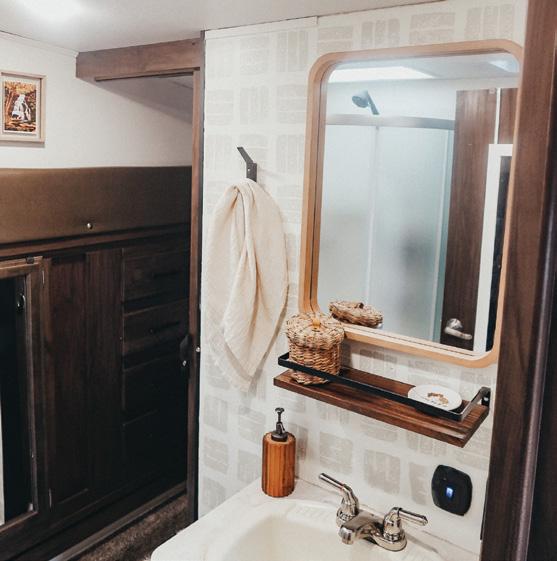



In the kitchen, we removed the tables and chairs to make room for more storage. We spend more time outside than inside, and don’t miss our table. Instead of buying new hardware to fit our style, we spray painted the existing hard ware a matte black, and for the kitchen backsplash, we used budget-friendly peel and stick subway tiles. I added an arched wicker shelf I found listed for free in my hometown for additional kitchen storage and a boho touch. Countertop space is precious, so adding a stove cover was also a must for meal prepping.
In the bathroom, we removed the
medicine cabinet, which put up quite a fight! We then sponge painted the front wall for an accent piece instead of spending money on wallpaper. We also added shelving for extra storage space. And of course, we updated the showerhead to a more practical and attractive option. The only renovation in the bedroom so far, other than a fresh coat of paint, is updating the headboard to faux shiplap. My main goal for each space was to find solutions that will hold up well over time, reflect our personalities, and be practical for full-time life in our tiny home on wheels!
These projects were extremely rewarding to complete, especially with no prior renovating experience. Seeing the finished project reflect our vision
excited us as we got ready to embark on the journey to becoming digital nomads. We had about three weeks to complete the renovations, and we’re proud of what we were able to get done in such a small amount of time! We have big plans for larger renovations in the future, but this process has taught us that the small things can make a huge difference. Even decorations play a large part in transforming a space to become a warm place to live. You don’t need a big budget to create a home, but rather the ideas, creativity, and drive to make it happen.
We love this lifestyle and enjoy hiking, foraging, and fishing in every place we have lived, along with our Bernese mountain dog, Mabel. We don’t necessarily have a plan for when we will settle down in a specific area, but we plan to spend seasonal time in areas we enjoy the most.
Follow Grace and Jacob on Instagram @reelandwildflower
MY WIFE, ASHLEIGH, and I have been on the road full time since September of 2020, but were part-time RV travelers since November of 2019. In this short time, we’ve had five different setups! Our first rig was a 33-foot travel trailer. Unfortunately, we got rear ended and it totaled our truck.

That led us to get a bigger truck that could tow more, and we decided to get a fifth wheel. We completely remodeled the fifth wheel, and shortly after, our little dog, Oreo, jumped on the counter, turning the faucet on when we weren’t home and flooding the RV. The resulting water damage was so severe that it was totaled as well. Our insurance company gave us more than we spent on it, so we upgraded again and bought a newer, bigger fifth wheel.
After traveling in the fifth wheel for almost a year, we decided we wanted to try something different, and bought a truck camper to give us more flexibility.
We’d only had the truck camper for a very short time when something terrible happened—one morning, when Ashleigh went to cook breakfast, our lives changed forever. She got all of the ingredients she needed, turned on the stove as usual, and the camper exploded.
The explosion caught Ashleigh on fire, singed the hair on all three of our animals, and everything inside the camper was in flames. I was outside getting something at the time when I heard the loud boom and Ashleigh screaming. She jumped out of the camper and ran to me, yelling for help. We were parked outside of a Cracker Barrel that morning, and a bunch of people came out to see what was going on.
All Ashleigh could do was lay in the cold wet grass and wait for the ambulance. After what seemed like forever, the ambulance came and took her to the University of Tennessee, but her

burns were so severe that they put her on an emergency flight to Vanderbilt University in Nashville, where they have a burn unit.
Upon arrival, they tested her for COVID and it came back positive. She didn’t actually have COVID at the time, but had a persistent positive still showing up from having it two months earlier. This meant Ashleigh couldn’t have any visitors almost the whole time she was in the hospital. She was in the worst pain of her life and I wasn’t allowed to be there for support. Twenty percent of her body was covered with first-,
second-, and third-degree burns. She went into surgery with the expectation that there would be multiple follow-up surgeries and that she would be getting skin grafts, but they were able to use the ReCell process instead of skin grafting, which is a lot less invasive and heals more quickly. The doctors take a piece of your skin and stretch and pull it to get all the cells into a spray that they then spray on the burns.

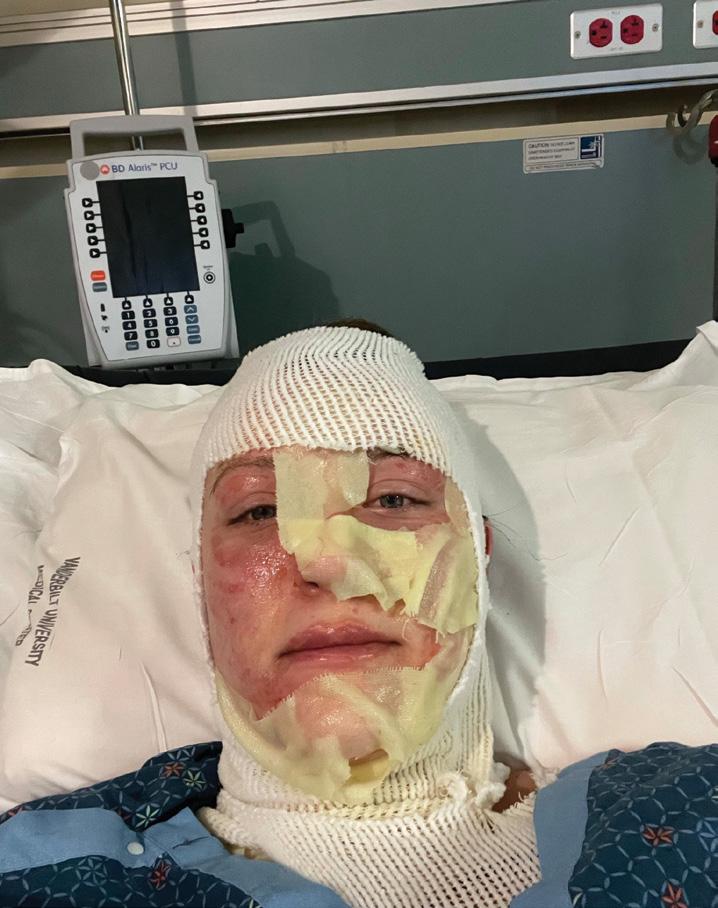
Ashleigh’s arms, hands, ankles, stomach, neck, and face were all burned, which meant she couldn’t do anything for herself. She couldn’t go to the bathroom by herself, stand up by herself, or even feed herself. She spent 11 horrific days in the hospital. They did wound care every day, which meant they had to take all the dressings off the burns and put new dressings on. Taking them off would rip off skin, leading to excruciating pain, along with the skin being exposed to the air, which burned. After 10 days, Ashleigh’s mom and I were able to enter the room and visit her. I was so eager to get her out of the hospital that I asked to learn the wound care routine the first day I was allowed inside the room. It proved to the doctors I could take care of her, and they let her go earlier than expected.
From there, we stayed in Airbnbs near Vanderbilt while Ashleigh had weekly followups. Many people assumed we would stop traveling and living in an RV, but the experience actually made us that much more grateful


for the life we have, and we were motivated to find our new home on wheels. I searched night and day until we found our new camper.
Since the explosion was caused by propane, we wanted a camper with electric appliances going forward. Before moving into our new Cirrus truck camper, I replaced the stovetop with an induction cooktop and switched the fridge to electric only. We power everything with 800 watts of solar that I installed. To this day, we still don’t know exactly what caused the explosion— whether it was a leak, faulty equipment, or something else—and unfortunately we’ll never know. Our insurance company investigated the accident and couldn’t determine the source of the problem.
The accident happened on October 23, 2021, and we bought our new camper almost exactly a month later, moving in a few weeks after that. Since then, we’ve been slowly working toward being comfortable again. The healing process has been, and will continue to be, hard for both of us. Mentally and physically, this is something we never thought we would go through, and every day is a challenge.

To facilitate a full recovery, Ashleigh has to stay out of the sun. When that’s unavoidable, she has to wear sunscreen, an SPF shirt, and a hat. She has to stretch consistently to get her skin back to how it was. Her skin can be very uncomfortable and she sometimes finds it hard to move, especially in colder temperatures. Since all her nerve endings burned off, she has a hard time feeling certain things—for example, a soft blanket doesn’t feel the same as
before, and our animal’s hair isn’t familiar. Her skin is also hyper-sensitive, making cold feel freezing and heat feel like fire. I massage the scar tissue for her several times a day to help mitigate scarring, and she has weekly therapy to help with her PTSD.
Ashleigh and I are so thankful to be alive and back on the road. She’s doing all she can to make the best of her situation and make a full recovery. Some days are great—her skin feels loose and not very swollen, and she doesn’t have any anxiety attacks. Other days she’s in so much pain that she can’t do much of anything and has anxiety attacks and flashbacks. Ashleigh puts her trust in God and knows that all things happen for a reason. This is just the start of our journey and we can’t wait to keep healing and exploring in our truck camper together!
Keep up with Grayson and Ashleigh’s adventure on Instagram @ourfulltimeadventure

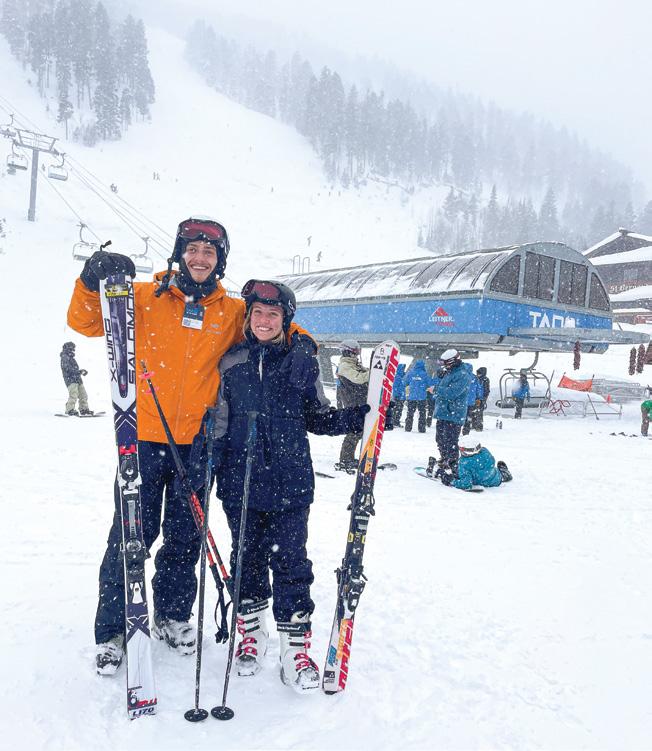
REGARDLESS OF THE context, the spirit of this quote runs deep for us. After several years of travel that took us from Key West, Florida, to Fairbanks, Alaska, and from the Cliffs of Moher to the jungles of Costa Rica, we decided to plant roots again. My wife, Reim, and I have struggled with this decision since the day we parked our rolling house in the driveway of our new homestead in Alaska.
When we sold our house and many of our possessions in 2017 to set out on our epic adventure, we thought we would travel for a year, then settle down in the mountains, already a far cry from the concrete jungle of Houston. But a year came and went, and we decided to keep going. I was able to sustain my consulting business and there was still so much to experience. The same thing happened after two years, and again after three years. We visited 49 states, plus parts of Canada, England, Scotland, Ireland, France, and Costa Rica.

In the beginning, our kids were in awe of everything. As they got older, I would point out things I thought were awesome, like a cool mountain, and they would respond, “Yeah dad … it's another mountain.” While they still appreciated what they were experiencing, we could see a significant change happening. Especially as they moved deeper into the Dark Ages, also known as the dreaded teenage years. They wanted a more traditional teenage experience: proms, basketball games, dating, and hanging out with the same group of friends. Our abnormal life seemed to have run its course, at least for the kids.

“I’ve never been one to stay still. I was born a nomad, and I still am a nomad and always will be.”
–Waris Dirie
It was different for Reim and me. We still enjoyed the excitement of wandering, experiencing new places, and the unknown each day seemed to bring. The routine of a stationary life didn’t appeal to us, but we had agreed from the beginning that we would stop traveling full time if we got to the point where the kids had enough. While they certainly don’t rule the roost, this lifestyle only works if we’re all on board. We needed to plant roots again.
We chose to settle in the idyllic little town of Talkeetna, Alaska. As the inspiration for the town featured in the TV series “Northern Exposure,” and with its postcard-worthy downtown, we were excited about this next chapter. We love the beauty of Alaska and the infinite opportunities to satisfy our thirst for adventure, so we thought being here was a workable compromise. There would be hiking, biking, backpacking, and fishing, all in arguably the most beautiful place in the world. The summer was fun. We integrated into the local community and worked on projects on our property. We were entering a dangerous place for Reim and me—settling into a routine.
When we told people we were moving to Alaska and would be staying
here during the winter, almost everyone thought we had lost our minds. But it was all part of the plan. My wife and I expected the winter to take its toll on our kids, and then we would hit them with a grand adventure to somewhere tropical. We would be wandering again, returning to Alaska during the summers where we could play in the midnight sun. I mean, no one in their right mind would want to spend more than one winter in Alaska, right?
Then disaster struck. Our daughter, who initially resisted the move, pledged her unwavering love for her new home state. “I love it here, and I never want to leave,” she said. Our son followed with his own sucker punch. “I want to take some classes at the high school,” he said. He’s in 11th grade, and we knew if he liked the classes and wanted to continue through graduation, that would mean we’re grounded for at least two years.
For Reim and me, the pull to be back on the road became stronger by the day. By the time tourist season was over in early fall and Talkeetna was settling in for what was to be a brutal winter, we were having daily discussions about how we could get back on the road, at least part time. I spent time surfing
sites for long-term rentals in Costa Rica, looking for house-sitting gigs in Europe, and planning another epic RV trip that would last several years.
Are Reim and I being selfish? Absolutely. We’ve earned that right. While our kids and their happiness are our main priority, Reim and I have a front-row seat on the mortality train, and it isn’t slowing down.

Maybe I’m being melodramatic. A bluebird day and a view of the Alaska Range is good to combat the doldrums of a stationary life, and summer is right around the corner. We love being Alaskans. We just love being nomads more.
For anyone who’s been to Alaska, you know the effect it has on you. There really is no other place like it. So, if we can’t be content being stationary here, it’s obvious to us we won’t be content being stationary anywhere. We are nomads now and forever. We know our rootless ways are far from over, but for now, we’ll enjoy watching our kids thrive, and we’ll embrace all that The Last Frontier has to offer.

Follow Jay and his family at ourwanderfullife.net



FINDING A WAY to fund travel is essential, which is why this is the number one most-asked question. The answer, however, is not so simple—from creative businesses to seasonal gigs to unique side hustles, our readers reveal how they make money on the road.



@wannaberetirees



“We’re remote call center managers.”
@travelingtiongsons
“I’m in digital marketing and writing. My husband is a workamper and personal trainer!”
@
“Hillary is a physical therapist, and David is a web developer.”

“Jerry

“I







Expandable Solar

System tiers for all budgets

Custom fabrication for desired system intergration
LIFESTYLE.

POWER. BUDGET. SOLUTION.
When we see a problem, we don’t just find a solution; we help make changes in the industry you’ve been waiting on that make your journey easier every single day. The products our team uses are the most innovative products on the market and we take the time to learn them inside and out so you don’t have to. With over 35 years of industry expertise, our team can design, fabricate, and install the Solar and Lithium system that’s fits your rig perfectly to make your battery life bigger.


IT’S BEEN MORE than three years since Adam asked me if I wanted to quit my job and sell our house and belongings to roam the country together in a travel trailer. Adam and I, along with our two Bengal cats, Roscoe and Rahja, went full time in May of 2019, saying “see you later” to our family and friends, and stepping far outside of our comfort zones in pursuit of a different way of life.

One of the most frequently asked questions we get while traveling is, “What do you do for money?” For a while our answer was “nothing,” because we had just sold our house. But just shy of our one-year mark, we decided to “settle down” and work our first seasonal campground gig in California. I subscribed to Workamper News, an email-based job board for nomads, and was receiving daily job updates that helped us find a five-month
commitment in the Redwoods. It was a wonderful first taste of what it’s like to make money on the road, and it was just the start!
Many people think that just because they wouldn’t be able to work remotely with their current role, it automatically means they could never travel full time. I’m here to tell you there are many opportunities to work while traveling, and most of them aren’t even remote.
Never in a million years did I think we would end up selling Christmas trees in 80-degree weather in south Florida for the holidays. But it’s one of our top experiences from life on the road. In the summer of 2020, we knew we really wanted to spend the upcoming winter in Florida. However, I quickly learned that it’s quite expensive and hard to reserve. Our backup plan was
to find another campground position that started right after our commitment in northern California completed. But most workamping positions in Florida are booked a year or more in advance! I was searching the Workamper News emails every day, waiting for something to pop up, and that’s when I was introduced to our first short-term gig!
A job for Christmas tree retail lot managers was posted in south Florida. The commitment was only about five to six weeks and promised a hefty base salary plus commission opportunities. The pay was more substantial than our last position, and we would only need to work a fraction of the time! It felt like the perfect opportunity.

We’ll be gearing up for our third season selling Christmas trees this year. We’ve already made lifelong friends and partnerships, plus we had the


top-grossing lot last season! We had the opportunity to visit the farm where the Christmas trees come from in North Carolina, right at the base of the Blue Ridge Mountains. This next season, we may get to help with pre-season preparation, which means more money and more time in Florida, but without the commitment of the entire winter.
Long before we went nomadic, I was dreaming of a completely remote job that would allow me the location freedom I desired. In the beginning of our RV life, I wasn’t searching in the right

places—I was only looking for writing jobs, which left me feeling exhausted and depleted by the amount of effort they took. Truthfully, the past few years of the pandemic have been a blessing in the remote world, with more opportunities out there now than ever before!
In the spring of 2021, I reached out to my former boss from a Minnesotabased credit union I worked for before RV life. I asked if they had transitioned any positions to remote, and if they had any openings. To my surprise, Human Resources quickly contacted me for a temporary remote position through the summer. Over the past few years, the company had gone completely remote and had more flexibility than ever before. One thing led to another, and before my temp assignment was up I was hired on permanently as their first traveling employee. Since they knew me and had worked

with me in the past, they allowed me to work with them while traveling, within certain parameters. I love that this position allows me to continue to use my administrative skills to power our journey!
One key thing we’ve learned over the past few years is that some of the best and most rewarding workamping jobs require the shortest time commitments. There is an opportunity in the Midwest each fall to partake in the Sugar Beet Harvest. A company called The Unbeetable Experience hires about 600 workers in northern Minnesota, North Dakota, and Montana.
This opportunity was another great find through Workamper News. The position was not as an entry-level beet sampler like other positions up north, but as a semi truck driver at a much higher pay—plus, the commitment was only for about three to four weeks! Adam also helped with other duties on the farm, such as harvesting soybeans and grain, and fixing farm equipment. The family hosted us in a small county park a few miles from the farm with a handful of other workampers.

I’ll never forget how excited Adam was the first few days he got to drive that 53-foot semi through the backroads of southern Minnesota, with no CDL needed, since it was a family farm. He said he felt like he was living out childhood dreams with all this farm equipment, and even though the hours were long, sometimes even 18-hour days, the gig flew by and we were on to the next great adventure.
Letting go of what we thought making money should look like was the best decision we made to keep funding our RV journey. It’s so exciting to start saying yes to all these opportunities we never would have had otherwise! We use our resources, like Workamper News and workamping Facebook groups, we talk to other RVers and ask what works for them, and in the process, we’ve started to pave our own way, too!
Follow Amanda on Instagram @sparkfireswan
AFTER MORE THAN eight months of dreaming, researching, and planning, I bought my very first home in April of 2020. I know a bus doesn’t look like most people’s first homes, but I’ve never really done things like everyone else, so why start now?
Meet Ruth Bader Ginsbus, Notorious B.U.S: a 1997 International 3800 mid-sized school bus turned rolling home! After purchasing the bus and completing the demo in Arizona, I headed north with my rescue husky, Mako, to build out the bus with my family in the Pacific Northwest. With a year of weekend work, my dad and I turned her into the tiny home of my dreams!

Everything on the bus, aside from the cabinets and the tech, was made from reclaimed wood, salvage yard scores, or thrift store finds. My father has worked in the marine industry since I can remember, so we affectionately
 By Kaetlynn Daoust
By Kaetlynn Daoust
nicknamed the bus “The School Boat” as she’s wired to American Boat and Yacht Council standards and full of marine technology. We wanted to keep the build smart but accessible so I could make repairs and changes while on the road.
The dream for my bus was never to travel the country or wake up in a new setting every morning. Over the last few years, I felt increasingly burdened by the “stuff” I had collected, how much waste I was generating, the water I was using, and the upkeep of a backyard I hardly ever
used. As an avid hiker and backpacker, I had the mindset and capability of tiny space living, but I had to ensure that my job and my health were met before I threw myself into this project.
I’ve been working in the marketing industry for more than a decade, and easily transitioned to full-time remote work during the pandemic. Besides working full time as a marketing director for a copywriting agency, I’m also a freelance copywriter, crafting ads, emails, websites, and more for various clients and companies across all industries. One hundred percent of my
job requires an internet connection, so I use an external cell phone hotspot and a signal booster. My simple internet setup allows me to do all the uploading, downloading, video conferencing, and streaming required for work. That being said, I choose to stay fairly close to major cities as I work Monday through Friday.
My home base is the desert of Arizona, where I wake up each morning to the sun peeking behind the mountains and fall asleep each night to it setting behind grand Saguaros. My reasoning for spending most of my time in Arizona is more than just temperate winters and stunning views, though—it’s mostly to play professional ultimate frisbee with the Arizona Sidewinders!

I am proud and honored to be part of the state’s sole professional ultimate team. Our season runs through the spring and requires a huge amount of dedication in time and physical fitness. As part of the Western Ultimate League, we play against other women’s ultimate teams across the West Coast. In order to stay in shape on the road, I carry a full adjustable dumbbell set, a stack of discs, and a sports net, and I make frequent trips to the gym and high school tracks around the cities I visit.

The team commitment requires me to be stationary in Arizona until our season wraps up in mid-May, which, conveniently, is when it gets too hot


to live comfortably in a tin box in the desert. After the season ends, I migrate to northern Arizona for a time before traveling up to Oregon for the rest of the summer to spend time with my partner, Dillon, who runs his own apparel business from Bend, Oregon.


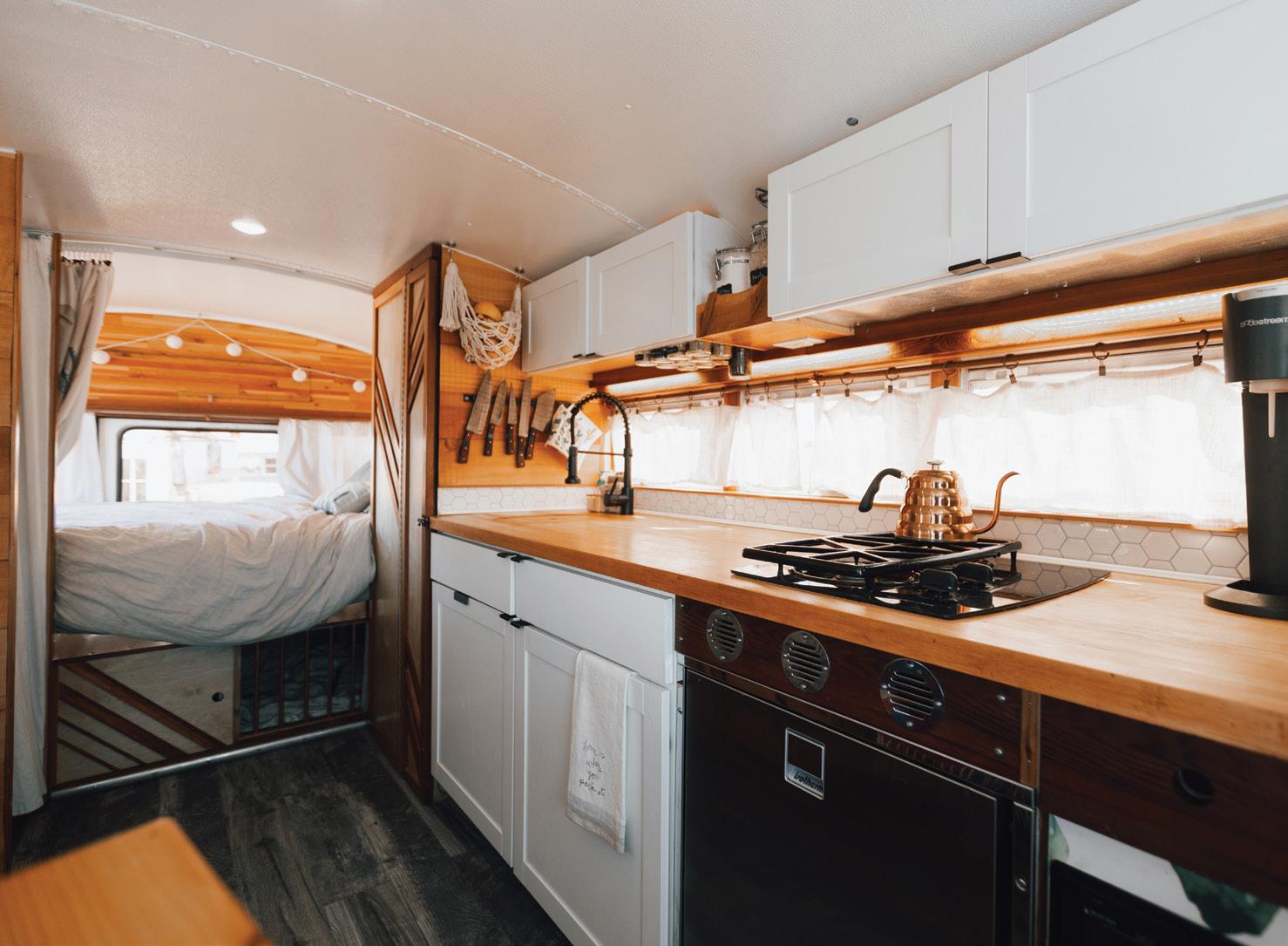
What I love about the nomad community and others who live in buses, vans, and RVs, is that there is no one right way to do it. Some have full-time jobs, some look for work on the road, some spend their nights tucked deep in the woods, some spend their nights in parking lots and on side streets, some do it for a short time, and some for the rest of their lives. No matter where we come from or where we’re going, life on the road teaches us so much about ourselves and our capacity for overcoming adversity with grace, patience, and resilience.

Every time I walk through the door of my bus, I feel more at peace, more centered, more grounded, and more at ease than ever before. Let me clarify— living in a bus is not easy, but living in my bus feels right. It feels comfortable. It feels like home. And it is home! No place has ever felt more like home than the 112 square feet of bus I built with my own two hands.
Follow Kaetlynn on Instagram @girlandhuskyWHEN PEOPLE GET into RVing, it usually feels like a scene out of a movie.
They get fed up with life, sell everything, buy their dream RV, then drive off into the sunset without a care in the world. My experience was the exact opposite.
Here’s how I got into RVing—my dad, who owned two businesses, had a stroke. Neither business was doing very well, so I had to drop everything to take over. I was living in the only housing situation I could afford, which was one of four bedrooms in a house with three friends. When our lease was coming up for renewal, we all sat down to talk about what we were going to do, and I found out they had made plans that didn’t involve me.
With only two weeks’ notice, I was left scrambling to find somewhere to live with no salary to back me up and the weight of my dad’s sickness and his failing businesses on my shoulders. Coupled with the disappointment of rejection from my friends, I was in a dark place.
A family friend who, as fate would have it, managed the KOA campground in our hometown, helped me move into a fifth wheel in his park and gave me a job at the front desk in exchange for my expenses.
I was so embarrassed about living in that RV. It was my rock bottom and I tried to keep it hidden. I thought living in an RV was for drug addicts, not mid-twenties recent college grads.
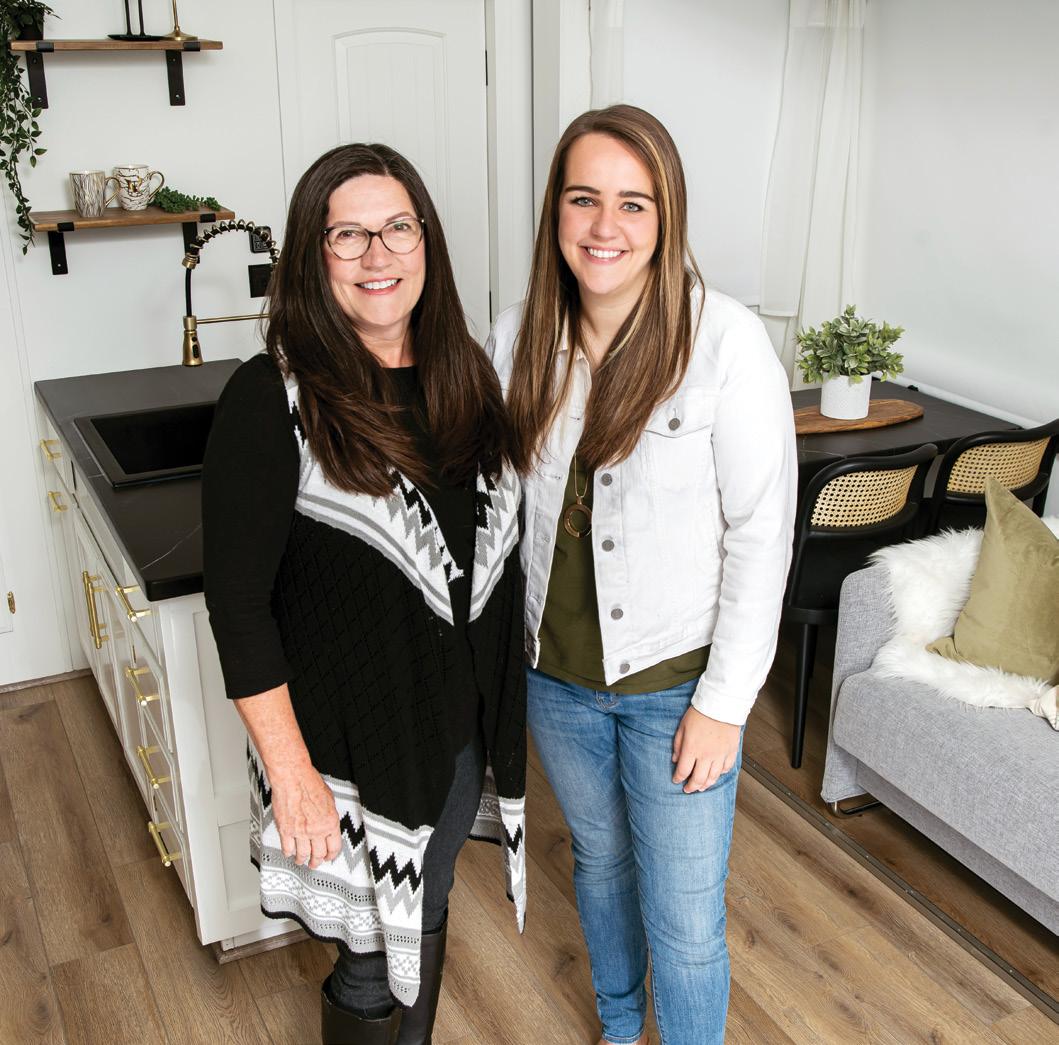


I decided working with rigs that had good bones and were built right was not just a good business practice, but a moral responsibility
During the first few months of my full-timing experience, the only entertainment I could afford was walking my dog around the RV park at night. But that would prove to be a turning point! I started recognizing how much everyone else loved RVing, which softened my attitude toward it. All my full-timer neighbors were happy-golucky, genuine, and extremely willing to help when I had questions. I also loved watching how upbeat and jovial the weekend visitors were. They were always barbecuing, playing yard games, and having a great time.
A few more months went by and I couldn’t deny it any longer—RV life was awesome!
The only problem was the interiors were not.
After a year of living in my first RV, I decided I wanted to keep living tiny, but I also wanted an RV that felt like a cute bachelorette pad. I set out on a quest to find one, thinking it couldn’t be that hard. I was wrong.

This was in 2014, before the currentday bright interiors were around. Back then, everything was dark, with bad floral prints and carpet that looked like it was purchased on clearance. None of the interiors looked as good as it felt to live tiny.
I finally found an RV that had the floor plan I wanted, but it was terribly ugly on the inside. I thought, “I could paint,

right?” I did a quick Google search, but nothing came up. I couldn’t accept this interior, but I also didn’t want to bail on living tiny, so I decided to take matters into my own hands. I renovated that regular RV into my tiny dream home, and it came out beautifully.


A few more years went by and everything was settled with my family, so now it was time to focus on what I wanted to do with my life. I kept coming back to my RV-buying experience and how I wasn’t able to find what I wanted. I thought there might be a business there, and wondered if other people felt the same about RV interiors.
I decided to give it a try, and the business took off, thanks to the power
None of the interiors looked as good as it felt to live tiny.
You've seen the before and after shots of ugly RVs transformed into beautiful spaces. You imagine doing that to your own RV but then reality starts to sink in. Just how are you going to pull this off? You know RVs are not like houses so is it OK to use residential techniques on them?


Cortni and The Flipping Nomad team has developed an all inclusive course teaching you everything you need to know to take your RV from factory to fabulous, all while being conscious of the RV structure. This course features over 100 modules teaching everything from how to build a shower to how to install lightweight flooring.
The course is online and selfpaced. You can access it at any time and rewatch as many times as you need to. Save 20% off Cortni's RV Courses with code ROOTLESS. Learn more at RootlessLiving. com/ theflippingnomad
of social media.
As the business grew, I recognized that many people were only interested in my RVs because of their interiors, and they were paying no attention to their structures. The roof could have rotted and the tires could have been shot, but the buyers were too wrapped up in the backsplash and the throw pillow to care. I decided working with rigs that had good bones and were built right was not just a good business practice, but a moral responsibility. For this reason, I started to look into which manufacturers were doing it right.

After a great deal of research, the Keystone Montana fifth wheel came up time and time again, and I decided to make Montana our brand of choice. After working with several Montanas, the Keystone team found out about what we were doing. Unbeknownst to us, they watched us online for several months.
In March of 2019, Keystone reached out and said, “Hey, we love what you’re doing, and we’d like to talk.” I couldn’t believe it! I was shocked they even knew I was alive, so it was even more shocking that they wanted to work together.
A month later, they flew me out to their headquarters in Goshen, Indiana, for a proposal. They told me a partnership like this had never happened in the industry before, so there was no ‘how-to’ book, but they’d like to work with me. We would have to make it up as we went, but we were all willing
to take the risk. They offered to pull a brand new Montana off the line, give it to me along with a budget, and let me build the craziest thing I could come up with.
I basically committed on the spot without knowing any further details.
In August of 2019, my team and I packed up our RVs and tools and temporarily moved to Indiana to build this masterpiece. We were there as the custom-built shell rolled off the assembly line. 30 minutes later, we were tearing it apart.
In December of 2019, we debuted the Ultimate Montana—an over-the-top, one-of-a-kind concept RV. It has some wild features, including a free-standing clawfoot bathtub, two water vapor fireplaces, an 80-inch projector screen TV, and a custom kegerator.
Since then, we’ve continued to see
massive growth in the demand for our interiors—we’ve even caught some corporate attention and recently turned a normal RV into a funky podcast studio for Lippert, one of the largest suppliers in the industry. We’ve also developed a course teaching DIYers how to renovate their own RVs.
This RV renovation journey has been a long and hard road full of unexpected twists and turns. It gives me pause to think about how I almost missed this lifestyle entirely. If my friends would have included me in that one fateful decision, I would not have my business and you would not be sitting here reading this article. It’s wild to think about the ripple effect of one simple decision.
Cortni and her team share their builds on Instagram @theflippingnomad and at theflippingnomad.com

It’s wild to think about the ripple effect of one simple decision.
HAVING A PLACE to work while traveling is important, but finding space in your RV to set up a workstation can be a challenge. We asked our readers to share their best office space ideas.

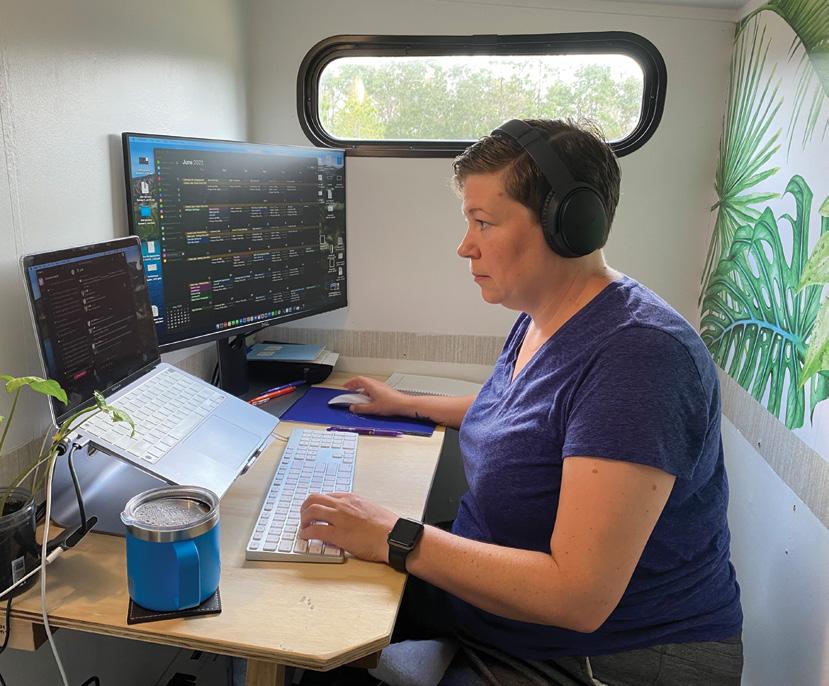
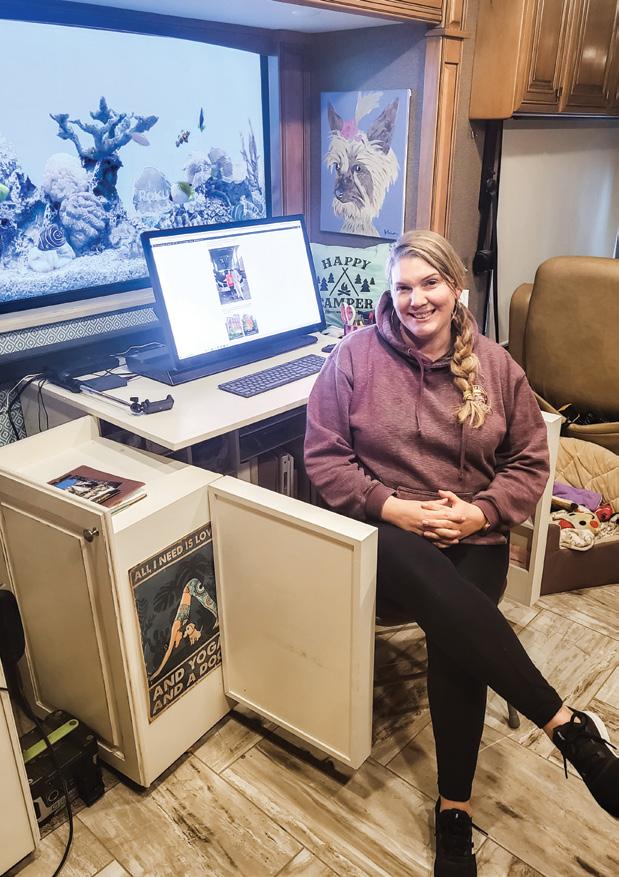
“Half-sized wardrobe-type desks with lots of storage!”
@home.sweet.serenity
@nikkirk7
“Removed the couch and put a desk in the corner with a window view”
@travelinperries
“Noise-canceling headphones, weBoost, and Calm meditation app”
@wander.onwheels
“Folding desk! Space doubles as storage for travel days!”
@happiness.on.the. highway
for
What tips do you have for creating a great RV office? Email us at collab@rootlessliving.com.


Just like every great road trip, sometimes life takes you in a new direction. At Heartland, we’ve launched a new journey to make our RVs better than ever. We’ve doubled down on seeking out the highest quality materials, creating fresh and inviting interiors and giving every unit the kinds of finishing touches you’d find in a new home.
Every unit goes through a top-to-tails inspection with a quality assurance expert—in fact, we have an 89,000-square-foot facility dedicated to walking each RV through a series of checklists to ensure it works exactly as it should. And with updated floor plans incorporating features our customers love best—spacious bathrooms, designer kitchens, furniture meant for cuddling up together—we’re confident every trip in a Heartland will be a happy one.
After all, that’s what RVing is all about: hitting the road with people you love, having adventures, making memories. So when you buy a Heartland, just focus on taking the journey of a lifetime. We’ll take care of the rest.


Experience the all-new Heartland online and check out 360-degree model tours, detailed floor plans, all-new features, galleries of updated decor and more.
Just visit HeartlandRVs.com.





AS A FAMILY of six—including three carpenters and myself, an interior stylist—we have an appreciation for a beautifully made and styled home. This can be seen in the 25-plus years we’ve been building, renovating, and styling houses. The world of adventure is also a huge part of our lives—we are full of wonder and excitement for travels, and we definitely have no shortage of incredible places to see here in Australia. This made us think about having the best of both worlds—the sanctuary of our gorgeous home and the thrill of travel.
In May 2020, I decided I wanted just that. I wanted to see more of the country we live in while also having all the comforts of home we so adore. I proposed the idea of renovating a
 By Jac Curtis
By Jac Curtis
vintage caravan—why couldn't we create a mini snippet of home to take with us? What was stopping us from creating another lovely home—this time on wheels?

Shopping honestly didn’t take any time at all. I think I spent an hour searching Facebook Marketplace and there she was—Olive. The 46-yearold caravan already had a name and was living a neglected existence in Byron Bay, New South Wales. I quickly messaged the owners to see if she was still available, and moments later a reply confirmed she was. I was so excited that I called my husband Curtis to tell him about it while already messaging the owner that we were really interested— oops! Curtis could hear the excitement in my voice and realized a caravan was soon coming our way. Yes, we bought
Olive sight unseen, which is probably not recommended, but she felt right and we thought, “Honestly, how bad could she be?”
Our 15-foot 1974 Viscount Ambassador made the trip from Byron to Brisbane, Queensland, with no issues. We immediately started giving Olive some much-needed TLC. She needed repairs to both sides of the chassis due to corrosion and a Z-channel that had snapped in multiple places. We also decided to repair and treat the chassis and get a new A-frame/ drawbar. This meant Olive could now house a spare tire, a new gas bottle, and a generously-sized toolbox. Other new additions at this stage included an updated jockey wheel, the coupling, hand brake, and safety chains. We were so happy to know all the structural work
had been completed and that Olive was stronger.
The following weeks were spent removing all the exterior cladding due to extensive hail damage that had caused three large holes. With this all removed, we were able to clean the entire aluminum framing and replace the frame and roof battens with the new four-seasons hatch, windows, and door.
Forty-six years of dirt, dust, and silicone had been uncovered, and we honestly thought this job would never end, but we were three months in and Olive was looking nothing like her former self. She had new sealed subflooring and a herringbone floor— but we weren’t done. We decided it was
time for installation, walls, and a ceiling.
We spent every weekend and spare evening working on Olive’s interior at our home while juggling our normal work weeks and family life. Added to this, we had sold our home and were getting ready to move out, which meant moving Olive mid-rebuild with no cladding, door, or windows.


Once we got settled, we started on our carefully-planned kitchen, complete with upper cabinetry, electric hob, granite sink, refrigerator, and a generously-sized bench top. Single longer-length bunks and a queen bed completed the layout before we began hours and hours of painting!


What seemed like years (and

countless coats of primers and paint tins) later, she was gleaming everywhere—even her backsplash was up and stealing the show. I absolutely loved creating the backsplash. It was a very satisfying project involving one box of white matte-finish tiles and a happy hammer.




I focused on simplicity for other aspects of the interior, which were all heavily influenced by my childhood memories of living in the beautiful Canaries. I chose antique brass for the faucet, fixtures, and fittings; beautiful raw timber for the table, which I made myself; rustic flooring; and a relaxed neutral palette.

Now we look back on photos and cannot believe how different our caravan looks. We are 20 months into our rebuild of Olive, and we are overjoyed, exhausted, and incredibly happy with how she looks today. We are so close to setting off on our lap of Australia while still having the comforts of our home.
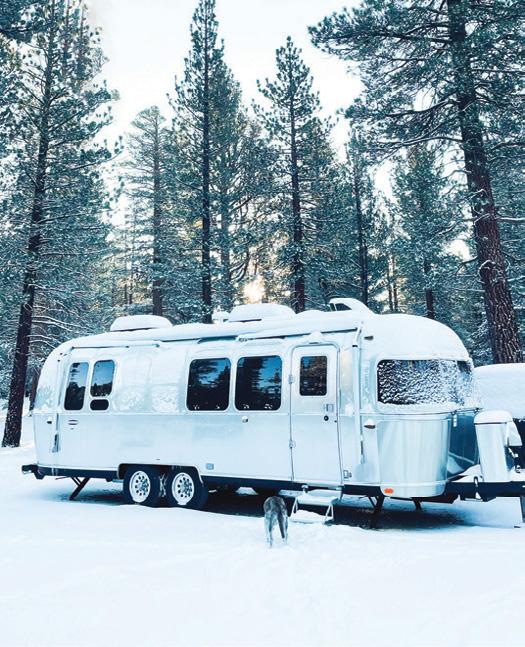

Keep up with Jac’s adventure on Instagram @seasons_with_olive









“Let’s sell our house and live in an RV!”
When my husband, Nathan, approached me with the idea of RV living, I was totally on board and excited for the journey. We sold almost everything, bought an RV, and have been traveling full time around North America with our two kids since May 2015. We’ve also renovated a few older RVs for our family travels along the way.

Our current home on wheels is a 2021 Grand Design 378MBS, and it’s perfect for our family. The mid-bunk layout provides separate sleeping spaces for our growing kids, and the amazing large windows are our favorite part! RV manufacturers have come a long way in terms of decor in recent years, and even though this particular RV was modern and sleek, it was not the personalized space we always strive to create for our full-time RV-living experience. I totally get that it feels wrong to make changes to a new and already beautiful RV, but I explain it like this: Would you want to walk into someone’s house and have it look exactly like your house? I loved our RV, but it was mass produced on an
 By Marissa Moss
By Marissa Moss
assembly line, and I wanted it to reflect our personal style and be individualized to our family’s needs.
Because the RV was brand new, we decided to wait a year to make any changes. Once our one-year commitment was complete, we were nervous and excited. Yes, we had experience renovating RVs in the past, but renovating a brand new RV was intimidating! We are somewhat handy, but for this project we enlisted help from our friends @livingsmalldreamingbig. They
had lots of reno experience and had recently renovated their own brand new RV, so bringing in expert help gave us the confidence to take on this project. We worked together, creating a vision board of design styles and color pallets, and started the process of bringing it to life. My husband and I have very different styles, so merging them is always a challenge. He is a hardcore minimalist and even brought up the idea of using bean bags as chairs. I’m not actually sure if he was serious,

I wanted an RV space that brought us joy and housed our memories
because I honestly shut it down very quickly. We found solutions, such as our leather couches from Article that we love. These couches were the perfect combination of cozy and comfy, and the leather became the focal point of the room, keeping it minimal and industrial at the same time. We searched far and wide for a couch that not only fit our style and comfort desires, but was also a comfortable place for guests to sleep, because it replaced our pull-out bed. We enjoy having family and friends join us on our travels, so the extra sleeping space is very important. One aspect that makes these couches super comfortable is the extra width! This allows for a great family lounging area to read books or have a perfect movie night, as well as provides extra space for guests to have a comfortable sleeping arrangement. The back cushions are also removable for even more usable sleeping space.
Let me share a little piece of advice we learned along the way on this remodel. We of course measured to ensure our couches would fit our living room space perfectly, but we missed the second measurement we needed, which was—you guessed it—the front door. We tried everything possible, but because of the mid-bunk


layout, we didn't have the space to make the turn. We went back and forth on what to do and finally decided to go through the window, which meant unsealing and removing it. Thankfully, our friend has a background as an RV tech as well! In the end, we were so happy with our decision to unseal the window, put our dream couch through it, and reseal it back as we found it. If you learn anything from our experience—first of all, measure the front door, but second, don't be afraid to get help moving residential furniture through the window if it’s the only way to get your dream furniture in!
Although we had some challenges to overcome, which happens in almost every reno, we couldn't be more happy with how it turned out. We broke this renovation down into three phases, starting with spraying the walls with a fresh white, adding a custom wood accent island and dining space, and replacing the bulky RV lights with residential lighting. We did add some weight with the wood, but we removed more weight than we added to keep it safe. In phase two, we sprayed the kitchen cabinets with a fun pop of color and created some open shelving. We removed the wine rack and replaced it with more functional wire baskets to display and store fruits and vegetables. Phase three will complete the renovation in the coming months.

Just like our sticks-andbricks home we sold to hit the road, I wanted an RV space that brought us joy and housed our memories. RVs don’t necessarily have to be renovated to do that, but we have found that creating a personalized space allows us to feel at home anywhere. Even though the scenery and ZIP code may change, our family space and the comfort of home remains. Our RV is the vessel that allows our family to create these amazing memories together across the country.

 Follow Nathan & Marissa on Instagram and YouTube @lessjunkmorejourney
Follow Nathan & Marissa on Instagram and YouTube @lessjunkmorejourney

THE ONLY 100% AUTOMATIC SHUT-OFF SAFETY DEVICE FOR YOUR PROPANE SYSTEM.


 By L. Merredith
By L. Merredith
WHEN MY HUSBAND, Andy, and I first got our 1965 Clark Cortez motorhome, we knew it would require tons of work—and this realization is echoed by every RVer who tackles a big renovation. From the preparation and demolition to the construction and installation, we polled our readers to learn which part of their RV work tested them the most.

Preparation is key, and simply having the right attitude for the job can go far. “Having patience is the worst part of RV renovations,” Pam Pederson said. She and her husband wanted a real door with sidelights on their 2019 Keystone Fuzion toy hauler. “The plan changed several times, frustration set in, and patience became the new normal! It was worth all the effort though—office view goal achieved!”



@justvisiting_adventures
Scope creep can be a complicating factor when you’re trying to keep your patience. It seems like Andy and I are never only working on one job, because one turns into three, or four, or more. The worst of this started during the mechanical work. We detected leaks, which caused us to remove ceiling panels, and that’s when we found soggy insulation. Removing the insulation then turned into a gutting, and that revealed rusted metal panels, which meant metal cutting and welding. Scope creep is undoubtedly the hardest part for us!
@soulofaseeker
Many people think demolition will be the fun part of a renovation, but the truth is it can be dirty, difficult, and time-consuming, which explains why many readers said this was the hardest part. Amanda and David Boles wrote, “Breaking apart all the ugly tile in the kitchen was the worst part—it made such a huge, dusty mess!”
@therollinboles
Lacey Reichwald also considered demolition the top challenge. “The worst part of our RV renovation was pulling out the 1984 carpet and the bajillion staples—each staple had to be removed with pliers,” she said. This is even worse when you consider her 1984 Blue Bird Wanderlodge is 35 feet long and the carpet even went up on the sides of the beds in the back room. “What I thought would be a one-hour task turned into a two-day job.”
@hunger.to.wander
Installation requires determination in a different sense—you’re so close to the end, but somehow this final stage takes so long to complete. Carla Geyer noted the work on her 2019 Grand Design Imagine 2960RL’s cabinet doors required two to three good coats of paint. “So. Many. Layers. Of. Paint,” she wrote. Multiple coats also means time waiting for each one to dry before flipping the door and painting the surface again. Her advice? “Grit your teeth and get it done."
@carlalikesparks
After demolition comes construction, and this phase can also be grueling and intense. Diana Ditkof wrote about her 2003 Shasta Cheyanne Class
C motorhome, “Sanding, sanding, sanding, and sanding again.”
@beerving_america
Meanwhile, the most dreaded job for Jason and Stephanie Miller called for them to put their muscles to use on their 2000 Jayco Kiwi 17A. “Trying to haul the heavy, new air conditioning unit onto the roof and place it was the worst,” Stephanie said.


@s_miller84
Reno work can be a nightmare, but it can often lead to great stories! And in the end, our readers confessed they were always glad they completed the work. Email us at collab@rootlessliving.com to share your RV renovation nightmare with our readers!
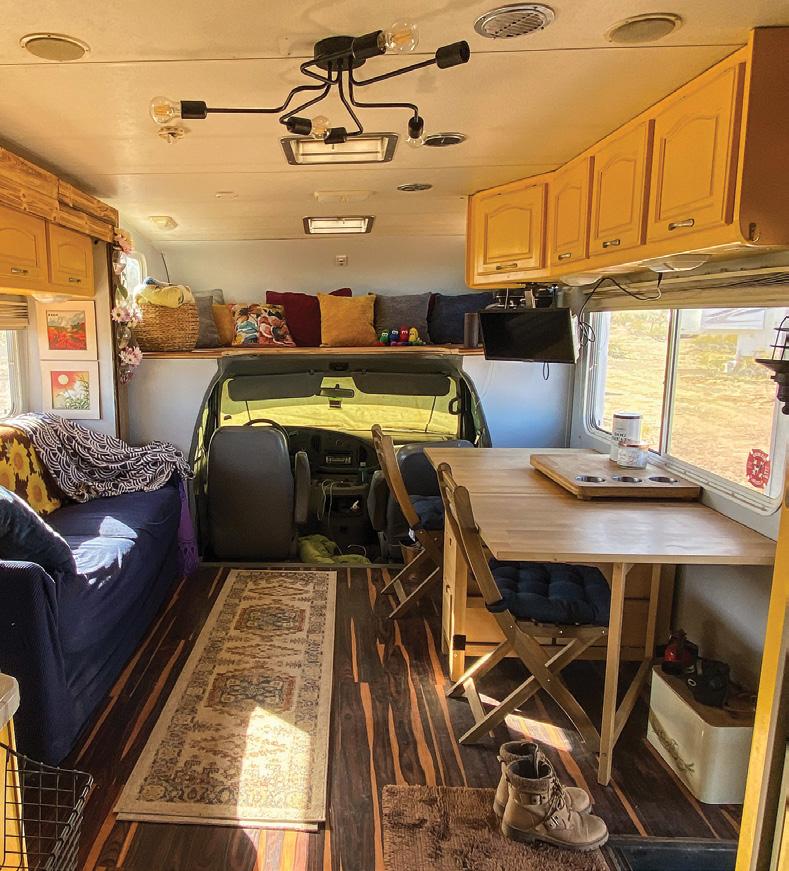


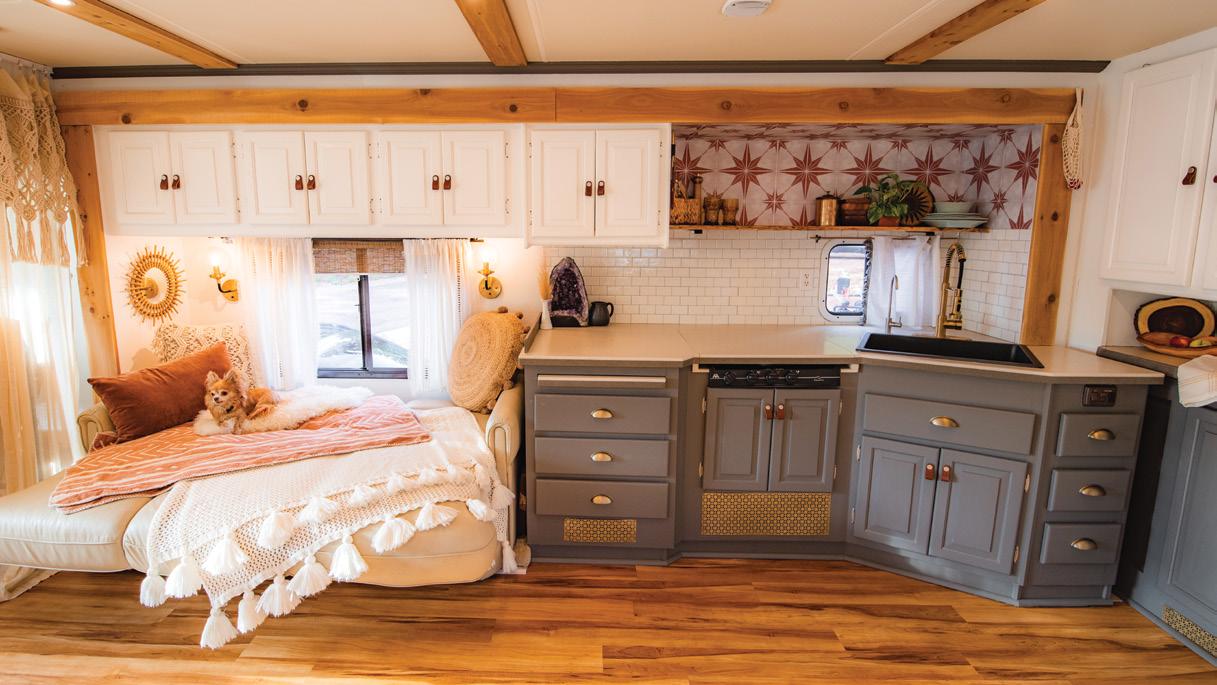
Beth Cronin has another tough installation story. “Replacing a curved ceiling in our vintage 1968 Sorrow Scotty camper became the worst renovation job,” she said. They used a PVC panel board because it was more pliable than the thinnest wood they could find. “A few swear words may have been spoken during the installation.”
@vintageglampers
Powered by a bluetooth-enabled system and customizable app, Echo provides the most advanced braking experience on the market. This unique controller utilizes your smartphone to control and monitor all trailer brake activity with no need for extra modules, controls, buttons or knobs. Echo is available in three configurations to best fit your lifestyle and vehicle.




• Zero-tool, plug-and-play install between vehicle-trailer 7-way connectors

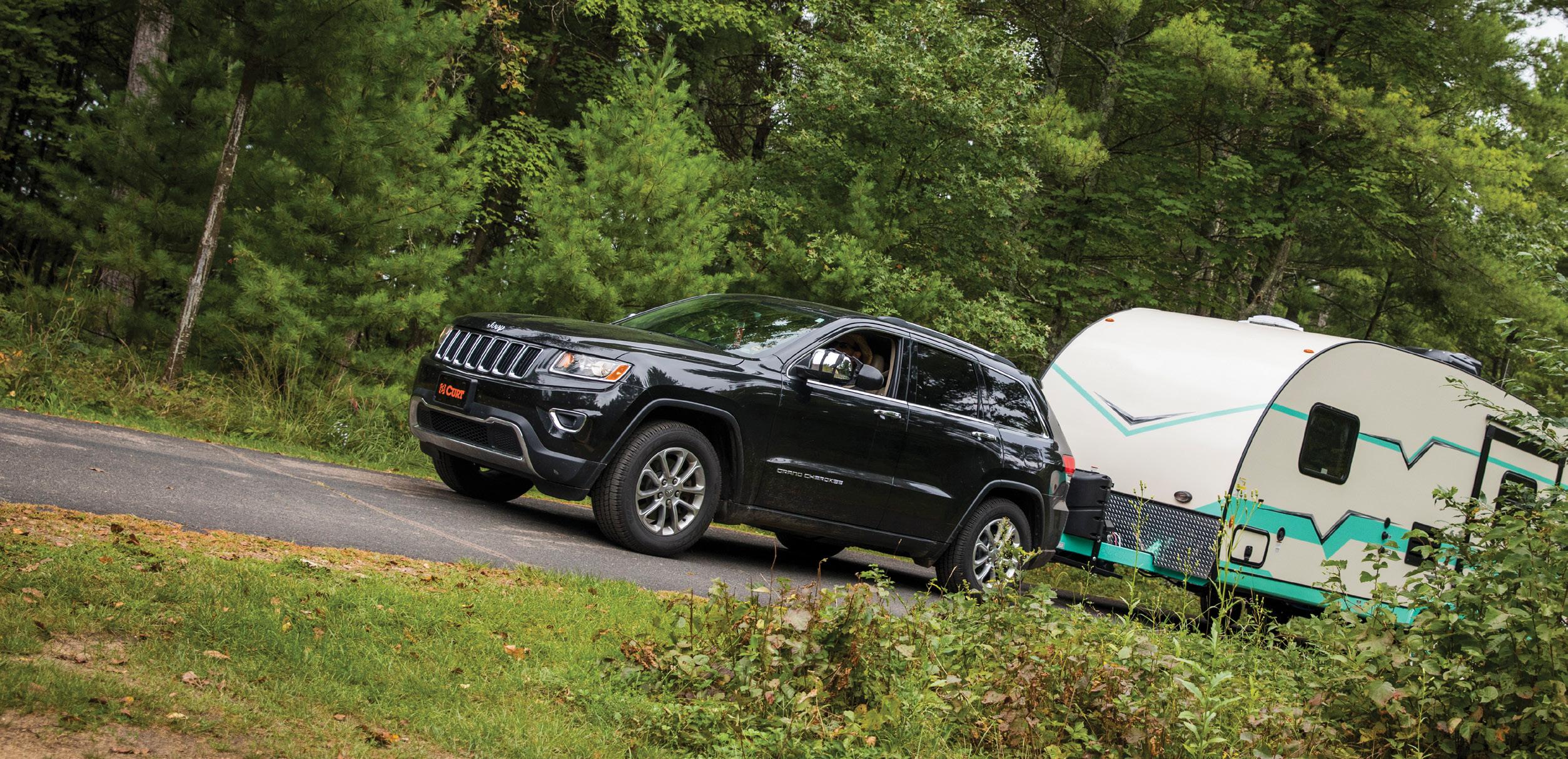
• Simple, dash-mounted installation using included adhesive pad or zip ties

WHEN WE MADE the impulsive decision to sell our Vancouver Island hobby farm and begin full-time RV life, we knew there were aspects we would miss. We knew we’d miss the neighbors and friends in our amazing little community of Shirley, British Columbia. We knew we’d miss our view of the Salish Sea and the stunning Pacific beaches and challenging hiking trails nearby. And we knew we’d miss hobby farming, complete with alpacas, chickens, geese, and a popular Airbnb.
What we didn’t know was what life as full-time RVers would look like for us. Prior to deciding on the nomadic lifestyle, we had never even been in an RV before! We always loved long road trips with no particular destination in mind—especially with our two sons. But with the kids grown up and out on their own, we figured we’d have a few years before we would start wanting to settle down close to our boys and their future families. We were years away from retirement, but we had the ability to work remotely while traveling.
We decided we didn’t need to wait until retirement to realize our longtime dream of extensive travel.
When we pulled out of our driveway in Shirley for the final time last April, we had a long list of places we wanted to see, but no particular plan on how we’d go about it. We couldn’t wait to see old road-trip favorites, such as Zion and Bryce Canyon, and friends the pandemic had kept from us in places like Kaleden and Saskatoon. We were also excited to spend time with family in places such as Ohio and North Carolina. But the place we were most looking forward to visiting was Nova Scotia.
Veronica was born in Nova Scotia—in North Sydney on Cape Breton Island, specifically—but she hadn’t been back home in almost 25 years. Aside from a couple of quick business trips to Halifax, I had never been to that historic part of Canada, nor had I met most of Veronica’s east coast family. When we made it to Canada’s “New Scotland” after five months on the road, we enjoyed it more than we expected.
Canada has beauty from coast to coast, but there are a handful of destinations in Nova Scotia that we would consider must-sees.

You simply must drive the Cabot Trail as part of a visit to Nova Scotia. We did the drive in one long day, but there’s no shortage of places to spend the night and soak in even more of the scenery and local culture. One such place is the famous Keltic Lodge in Ingonish, which is a great place to stop for lunch
 By Jeff Roby
By Jeff Roby
and photos even if you aren’t able to spend the night. There are countless amazing views along the trail, and more than a few quaint towns. Be sure to take advantage of as many of the scenic viewpoints and pull-outs as you can. I recommend driving the trail in a counterclockwise direction so not even passing cars separate you from the amazing ocean views.

Without a doubt, Lunenburg was one of our absolute favorite places during our first year of full-time travel. We loved it so much, in fact, that we extended our stay in this picturesque town twice! The narrow, hilly streets provide fantastic views of the colorful working harbor from every intersection, with no shortage of options for fresh seafood or a cold beer. One of the best things about visiting Lunenburg by RV is the easily-accessible municipal RV park in the heart of the city. It’s reasonably priced and allows you to stroll through the historic town without needing a vehicle. Don’t forget to tour the world-famous Bluenose II if she happens to be in port during your stay.
HALIFAX

Nova Scotia’s capital is a thriving modern city that maintains the friendly feel of a quaint harbor town. You can easily spend a day walking among the shops, pubs, and restaurants to explore the welcoming waterfront—the same waterfront that has welcomed countless immigrants to Canada over hundreds of years. For us, the star of the city was the hilltop citadel. This impressive site watches over the city as a present-day reminder of the province’s rich military history. We stayed at a KOA outside of Halifax for a few days to allow for easy day trips into the city.
You may never find a more picturesque place than tiny Peggy’s Cove. This small fishing village is filled with maritime history, but has significantly expanded its infrastructure to support visiting tourists since our first visit there almost 10 years ago. The lighthouse at Peggy’s Point is iconic, as are the wharfs and cottages dotting the small natural harbor. What we hadn’t known prior to our visit was that there’s a network of beautiful hiking and walking trails outside of town, providing wonderful views of both the village and Cabot Trail



 HalifaxCitadel
PeggysCove
HalifaxCitadel
PeggysCove
the sparkling waters of the Atlantic Ocean. Also outside of town is a somber memorial to the passengers and crew of Swissair Flight 111, a trans-Atlantic flight that crashed into the ocean miles offshore in September 1998.


Veronica’s cousin suggested we check out Nova Scotia’s Sunrise Trail, and we were certainly glad we did. On a clear day, you can see Prince Edward Island from the lovely Cape George Point Lighthouse. There are many other fantastic views and points of interest on this drive along Nova Scotia’s northeast coast. You’ll definitely want to check out Antigonish. Don’t forget to have a little cash with you when you explore this part of the province—some of the best food you’ll find is in the tiny shops in small fishing villages where they don’t take credit cards.

There were so many other places we loved during our time in Nova Scotia. We were able to drive our 4x4 on the sand at Crescent Beach, and we loved Hirtle’s Beach so much that we almost bought an oceanfront lot. We also enjoyed the Bay of Fundy, which we visited during a fittingly gray and stormy day.
This is not even close to a definitive list of the must-visit destinations in this incredible province. We made it to some of them, but we couldn’t see everything we wanted in one trip. We’ll be back for more on our next lap of North America, and can’t wait to get there again.
Follow Jeff on Instagram @big_rv_journey
Crescent Beach Cape George Point Lighthouse





THERE IS ONE park in America that is so big, grand, biodiverse, and culturally rich that it has the word “Great” in its name—Great Smoky Mountains National Park. And just one look at the landscape, with the mountains rising in layers as they elevate toward the sky, leaves no doubt about how the word “Smoky” came to describe the area.
Great Smoky Mountains National Park straddles the border of Tennessee and North Carolina. There are four gateway towns you can stay in that lead into the park—Townsend and Gatlinburg on the
Tennessee side, and Cherokee and Bryson City on the North Carolina side.
To visit the quieter side of the Smokies, plan your stay in Townsend. This location makes for a good base camp if you want to spend time in Cades Cove.


If you’re more of a city person, you might choose to stay in Gatlinburg. It’s near Pigeon Forge and is the most popular option of the four. There are plenty of shops, restaurants, and tourist attractions here.
Cherokee is in the Qualla Boundary. A stay here will allow quick access to Mingo Falls, with many restaurants, plus shopping and a casino.
Last, there is Bryson City. If you’re up for tubing, kayaking, or whitewater rafting, head here, though campgrounds may be closed in winter.
For a more primitive experience, you can also choose to stay at one of 10 campgrounds inside the park.
According to recent research, the area may have been inhabited as early as 8000 B.C., but the remnants of settlers from more recent centuries stand out in the sprawling park landscape. Homes, churches, log cabins, and buildings are still there for visitors to see and explore.
Before these settlers, the Cherokee had already established roots in the area. Today, the Eastern Band of Cherokee Indians in the Qualla Boundary south of the park are descendants of those not forcibly removed in the 1830s. In the early 1900s, loggers nearly wiped out the forested area, but the national park designation in 1934 protected what remained. Today, the National Park Service touts this area as America’s most visited national park. The roots here run deep and the culture is diverse. The national park plays an important role in protecting this area of Southern Appalachia.
The park is open year-round and has no entrance fees. The time of year you choose to visit will depend on your preferences. If you’re after blooming wildflowers, head there in spring. If you’re trying to avoid the crowds, be sure to avoid the summer, when the park is at its busiest. The layers of lush mountainsides and rolling hills against the sky are amplified in the fall. While winter in the park is beautiful, some of the popular drives and sites might be closed due to snow and ice.
There’s more to experience in Gatlinburg, too, including:

Mount LeConte Scenic
Overlook
SkyBridge
Anakeesta
Ripley’s Aquarium
Great Smoky Arts and Crafts Community

Plan ample time for sightseeing. Scenic drives can take a couple of hours.
An RV GPS is helpful, as some of the Tennessee roads are not big rig friendly. Scout out spots in advance via car or truck prior to taking your RV.
Cell service is spotty throughout the park, so plan ahead with backup maps.
According to the National Park Service, scientists estimate there are two bears per square mile in the park. Know how to prevent and handle bear situations before you get there.
Grotto Falls is 2.6 miles out and back and rated as a moderate trail. We spent a few hours hiking through an old-growth Hemlock forest, and the reward at the end is 25-foot-high Grotto Falls, with its own unique
feature—you can walk behind the water.
To get to the parking area for Grotto Falls, you’ll drive Roaring Fork Motor Nature Trail. This scenic drive is closed in winter, but visit in other seasons to soak in the beauty of the national park from your car. The road is narrow, one-way, long, and winding. Along this path, you can observe dense forests, beautiful cascades, and structures from bygone eras.
Another leisurely drive is on Cades Cove Loop Road. Approximately two million people travel this road each year, and there’s nothing quick about it—plan for anywhere from two to six
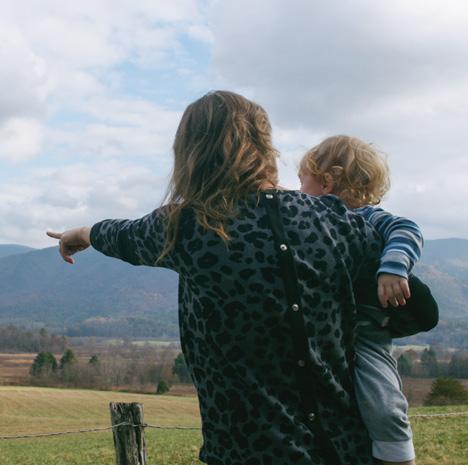
hours. This 11-mile drive is one lane, one way, and goes through the cove, where a community thrived for more than 100 years. Get out and stretch your legs at any of the many sites along the way. This is a prime area to view wildlife— all our bear sightings were in Cades Cove.
One bear was in a busy area by restrooms, and a mama bear and three cubs walked behind our car. While I was hoping we’d see a bear at a distance, I didn’t realize how unavoidable they would be.
Also in Cades Cove is the John Oliver cabin, which is one of the oldest structures in the park and one of the first structures you’ll come across on this scenic drive. You can access it through a short walk in the woods from a small parking area. There is also a

• Stay more than 50 yards away
• Check the NPS website for bear activity and closures

• Put trash in bear-proof trash cans
• Don’t leave food out at campsites
• Store food properly at campsites
• Carry EPA-registered bear spray with one to two percent capsaicin
Great Smoky Mountains National Park features more than 100 waterfalls. Here are the most popular hikes to waterfalls:

Abrams Falls
5 miles round trip, moderate Grotto Falls
2.6 miles round trip, moderate Hen Wallow Falls
4.4 miles round trip, moderate Indian Creek and Toms Branch Falls
1.6 miles round trip, easy
Juney Whank Falls
0.8 miles, moderate
Laurel Falls
2.6 miles round trip, moderate
Mingo Falls
0.4 miles, moderate
Mouse Creek Falls
4 miles round trip, moderate Rainbow Falls
5.4 miles round trip, moderate
Ramsey Cascades
8 miles round trip, strenuous
paved path to the property. Once there, walk inside and get a glimpse at what life was like in the early 1800s.

A steep, half-mile paved path takes you to the top of Clingmans Dome Observation Tower. It’s the highest point in the park and it crosses the Appalachian Trail. The view is spectacular and provides visibility of more than 100 miles on clear days. The road to the tower is closed in winter.
This trip fulfilled my birthday wish of going somewhere amazing with my family. Experiencing the awe and wonderment that comes along with seeing something naturally astonishing together was a perfect gift.
Jamie wrote “The Proving Ground: A 12-Month Solo Road Trip Across America.” Follow her on Instagram at @jypsythreads
Photos courtesy Ryan Bilinski and Mountain Escape Photography.







 By Kathryn Frazer
By Kathryn Frazer
CALIFORNIA IS HOME to nine national parks—more than any other state—and
Joshua Tree National Park is located less than three hours from both Los Angeles and San Diego. This park is a popular destination on Southern California adventures and receives 3 million visitors a year. And for good reason— there is magic in the park that brings a sense of wonder. It feels like a giant playground, with unique plants to admire, mining ruins to check out, and tons of boulders to play on. We weren’t as excited to visit this park as some others, but we ended up having a blast, and felt like kids as we explored!
In this guide we’re sharing all you need to know about visiting Joshua Tree National Park, plus a guide to one perfect day seeing its top sights.

Joshua Tree National Park is named after the most iconic sight in the park—Joshua trees. These plants have a unique look, with twisted arms and spiky leaves. Despite their name, Joshua trees are not actually trees, and are instead part of the agave family.
Native Americans—such as the local Cahuilla—call the plant “humwichawa,” and used its leaves to make baskets and sandals. They also used the seeds in their diets. It wasn’t until the mid-19th century, when Mormon immigrants visited the area, that the trees were given the name Joshua tree, which is said to refer to the biblical figure, Joshua. Since the plants are not trees and do not have growth rings, it’s hard to determine their age. However, a Joshua tree grows half an inch to three inches per year on average, reaching heights of up to 40 feet and living more than 150 years.
Besides Joshua trees, the park features expansive desert views across both the Colorado and Mojave deserts, six distinct mountain ranges, and a history of mining, which you can still see today.
Joshua trees are not actually trees, and are instead part of the agave family.
Native Americans— such as the local Cahuilla—call the plant “humwichawa,”
The park is open year-round, but for the best weather, visit between the late fall and early spring, as temperatures are cooler. In the summertime, the park regularly sees temperatures of more than 100 degrees!
One thought to keep in mind when visiting is that the park ranges in elevation—from 536 feet up to 5,814 feet—so the weather can vary depending on your location. Be sure to pack layers!
Joshua Tree National Park has eight campgrounds, plus a group campground. Most of these campgrounds take reservations, which are highly recommended, while a few are first come, first served.



Outside of the park, both the north and south entrances have free dispersed camping nearby. We stayed at both, and while we preferred the south camping area, the north was more convenient to some of the top sights in the park.
If you’re looking for more traditional lodging, Palm Springs is less than an hour away from both park entrances and has many hotels and Airbnbs.
Entrance fee
It costs $30 per car to enter the park, which covers seven days. We recommend purchasing an America the Beautiful annual pass for $80, which gives you access to all national parks.
One full day will allow you to see the top sights in the park, but two days will give you the chance to go more off the beaten path and enjoy the area at a slower pace. That said, we’re including a one-day itinerary at the end of this article to help you get started with planning!
Dogs are not allowed on any park trails, but are allowed within 100 feet of roads, campgrounds, and picnic areas, as well as on any unpaved roads.
There is no shuttle
You will need your own vehicle to get around, as many sights are spread out.
Hidden Valley Nature Trail
The northern part of the park is the best spot
• Joshua trees can grow to be 40 feet tall and live more than 150 years
• The park is less than three hours from San Diego and Los Angeles
• The best place to see Joshua trees is in the northern part of the park



to see tons of Joshua trees, and the Hidden Valley area is full of them! Along this 1-mile trail, you’ll hike among rock formations and see a valley full of Joshua trees.

Tip: After your hike, go down the trail by the picnic area to see even more Joshua trees!
Hall of Horrors is a narrow passageway through rocks that is popular with rock climbers and some hikers. It can be a bit tricky to find—to get there, walk around the right side of the first giant rock formation from the parking lot. Once you get to the second formation, go left, then scramble up rocks to get into the entrance.
Ryan Mountain is one of the best hikes in the park if you want views of the area! This 3-mile trail climbs more than 1,000 feet to the second-tallest peak in the park. At the top, you’ll have mountain

views around you, as well as a unique perspective looking down into the park.
The 1.3-mile Barker Dam trail takes you to a dam that was originally built by cattlemen in 1900 before being built a few feet taller in 1949. After it rains, the area fills with water, which is a unique sight in the desert. It was dry during our visit, but the rocky scenery, petroglyphs, and dam make the short hike worth it.
At its peak, the Joshua Tree area was home to 300 mines, and today you can explore mine ruins on a handful of trails, which is a fun way to see a different type of history in the park!

The Wall Street Mill trail is 2.4 miles. Along the way to the mill, you’ll see building ruins, old cars, and machinery. We really enjoyed this hike!
Along the 3.4-mile Queen Mine trail, you’ll get to see some of the mine and the historic Boulder House. The trail
isn’t very well marked, so be sure to download the offline AllTrails map!
The Lost Horse Mine was one of the highest-producing mines in Joshua Tree, and along the 4-mile trail, which follows the road that was developed to haul ore, you’ll be able to catch a glimpse of impressive mine ruins.
Keys Ranch is the former home of the Keys family and requires a guided tour to visit. On the 90-minute tour ($10 for adults and less for kids and seniors), you’ll get to see the ranch and learn what it was like to homestead in such a tough desert climate.
Keys View
Keys View is the highest point you can drive to in the park at 5,185 feet above sea level. At the top, you’ll experience panoramic views of the Coachella Valley and the San Andreas Fault. This is also a great sunset spot!
Skull Rock
Skull Rock is a giant boulder that looks like a skull and is an easy roadside stop, so of course it’s also a very popular photo spot. During our visit, there was a line to get a photo of the rock.
Arch Rock
Arch Rock was one of the highlights during our time in Joshua Tree! This

Ready to see the park for yourself? Here is our suggested one-day itinerary, which will take you to the major highlights!
1. Watch the sunrise at Keys View.
2. Hike to the top of Ryan Mountain.
3. Admire the Joshua trees in the Hidden Valley area.
4. Visit Barker Dam and Wall Street Mill from the same parking lot.
5. Snap a photo of Skull Rock.
6. Hike to Arch Rock and play on the boulders.
7. Watch the sunset at the Cholla Cactus Garden.
8. Enjoy the night sky!
short and flat 1.2-mile trail takes you to a small arch in the middle of a boulder field. The arch alone is really neat, but we equally enjoyed climbing through the boulders and going through mini slot canyons. If you have extra time, add on the 0.4 miles to Heart Rock as well!
Cholla Cactus Garden
This area is full of teddy bear cholla, which are not seen very often in the rest of the park—especially in this quantity. They are gorgeous at any time of day, but visit around sunrise or an hour before sunset (before the sun tucks behind the mountains) to see them glow a gorgeous golden color!
For the more adventurous, rock climbing and bouldering is a classic activity in the park, with 8,000 climbing routes and 2,000 boulder problems. For those who are new to climbing, there are multiple guide companies that can teach you!
Experience the night sky
Joshua Tree is an International Dark Sky Park, so it’s a stargazer's dream. If you’re not too tired after adventuring, stick around in the park to see the stars and maybe even the Milky Way!
Follow Kathryn on Instagram @adventuresofaplusk

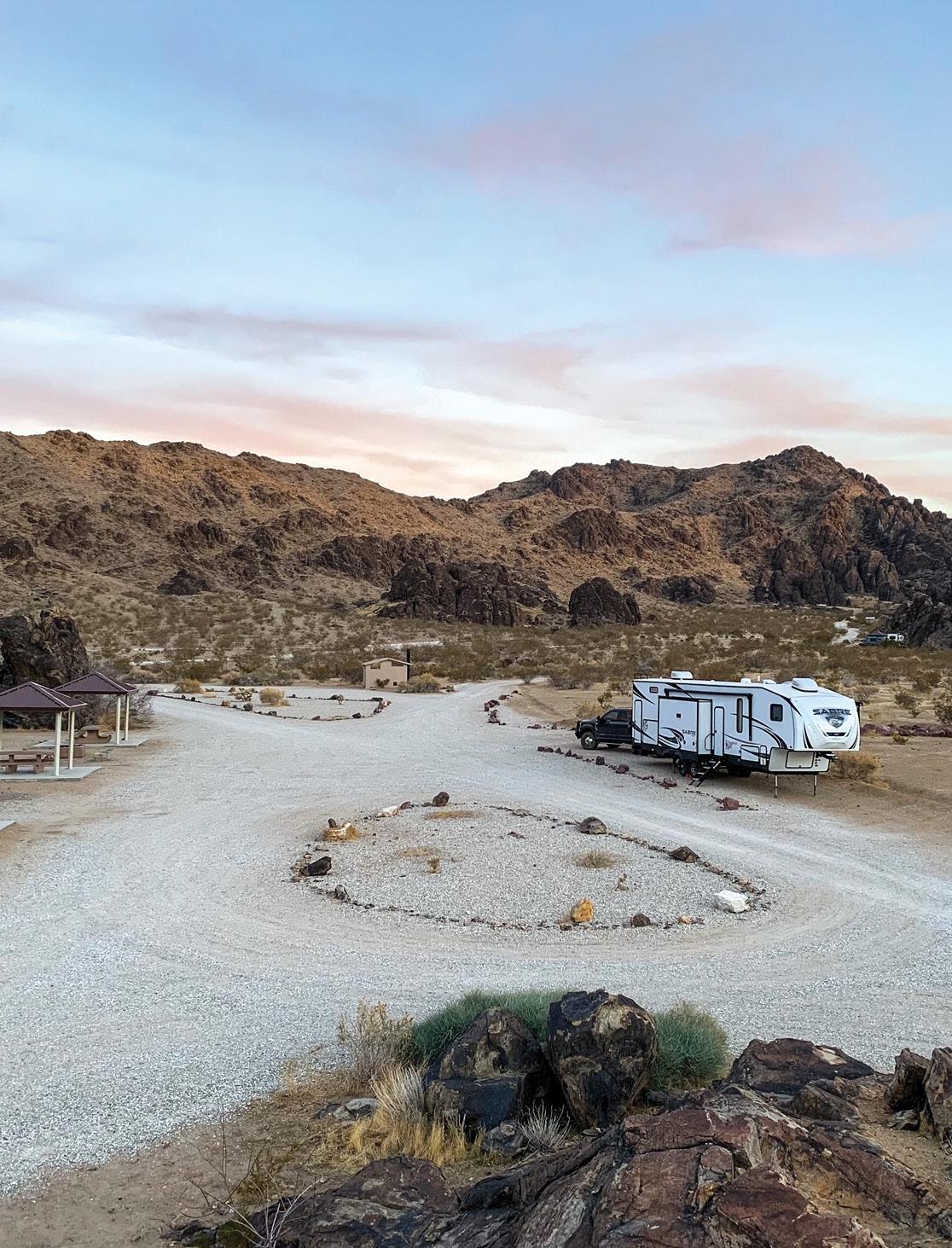
GPS Location: 34.670299, -116.983985
Sawtooth Canyon Campground is located on Bureau of Land Management land in Southern California and is one of the best free boondocking spots we’ve found in the desert. Spots are first come, first served and big rig friendly. We saw many rock climbers, as there are plenty of climbing opportunities in the park. There is a small area with dinosaur bones for the kids to play on, plus picnic tables, trash cans, and restrooms, which are always nice when you’re dry camping. The sunsets are amazing here! It’s about three hours from both Los Angeles and San Diego, so you could even take a day trip into the city.
Follow Brooklyn Durell on Instagram @durellsdownsize

GPS Location: 44.615614, -111.417343
You might be surprised by how few boondocking locations are available outside of Yellowstone National Park, considering the park’s size and popularity. Our friends suggested this beautiful lakeside spot called Henry Lake BLM, which is located about 30 minutes away from West Yellowstone. It was a much more scenic option than the popular Bootjack dispersed camping, and not much farther of a drive. The turn off the road is just past a small RV park and includes a long, winding hill to get down to the water. It's a small area with very limited room to turn around, so I suggest scoping it out prior to towing a big rig down there. Watch out for cows as well!


Follow Kristin Halls on Instagram @kristininmotion

GPS Location: 34.714000, -114.434997
If finding a place to boondock is a challenge for your big rig, this spot north of Lake Havasu, Arizona, is a great option for you! Just east of the California–Arizona border on Highway 40, you’ll find the Needle Mountain Road boondocking area. Here you can easily find a spot at the entrance, or if you’d like more privacy you can drive in a little farther to this wide open space with amazing views and tons to explore.
If you choose to keep driving for these spaces, know that the road gets a bit narrow, so while four-wheel drive isn’t a must for the spots at the entrance, it helps when getting to the coordinates listed above. It was totally worth it for us because we found almost perfectly-level spots with fire rings waiting for us to easily pull into.
If you have little ones, they will love the sandy hills to play on, the washed-out canyons to explore, the space to run around or ride their bikes, and all the rocks they can fit into their pockets and your camper! Have toys with you? You’ll find endless options for ATV trails here as well.

While this location is easily accessible from the highway, we heard very little road noise and enjoyed amazing sunsets and night sky views.
We had great AT&T and T-Mobile service while boondocking here, which is essential for our nomadic lifestyle. With only a couple of other RVs in the area, we had no problem running our generator when needed and felt safe and secure.
We found this location on Campendium and we’re so happy we did! This was a one-night stop for us, but we wish we would have planned to stay longer and we would not hesitate to go back in the future.
Whether you’re looking for a stopover spot or a place to stay for a while, be sure to check out this great, big-rig-friendly boondocking spot.
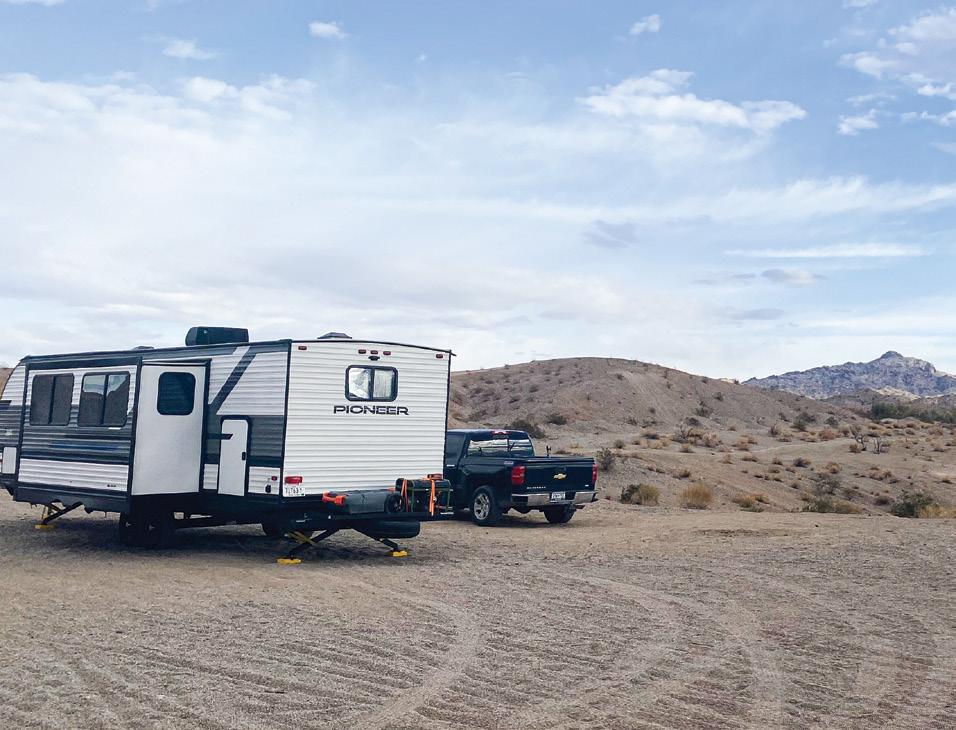 Follow Carrie Shoemaker on Instagram @peaceloveandfamilyadventures
Follow Carrie Shoemaker on Instagram @peaceloveandfamilyadventures





Available in different colors, these lightweight peel and stick tiles can be cut to fit and are easy to install. They add a perfect finishing touch to your RV renovation.
Drastically cut the time you spend painting with a Graco paint sprayer. It's available in different sizes, easy to clean, and gives your renovation a professional look.
Need to make something stick or stay in place? Weldwood contact cement can be used on wood, leather, laminate, and more. The nonflammable formula is perfect for RVs.
For redoing upholstery or other DIY projects around the rig, this staple gun is easy to handle and can be used with three different types of staples.
Available in different colors, this peel and stick wallpaper is great for creating an accent wall or brightening up a small space. It's also easily removable, which helps when you're ready for a new look.
More light is always a good thing, especially under cabinets and in closets. These lights stick anywhere with no wiring needed, and they're rechargeable.
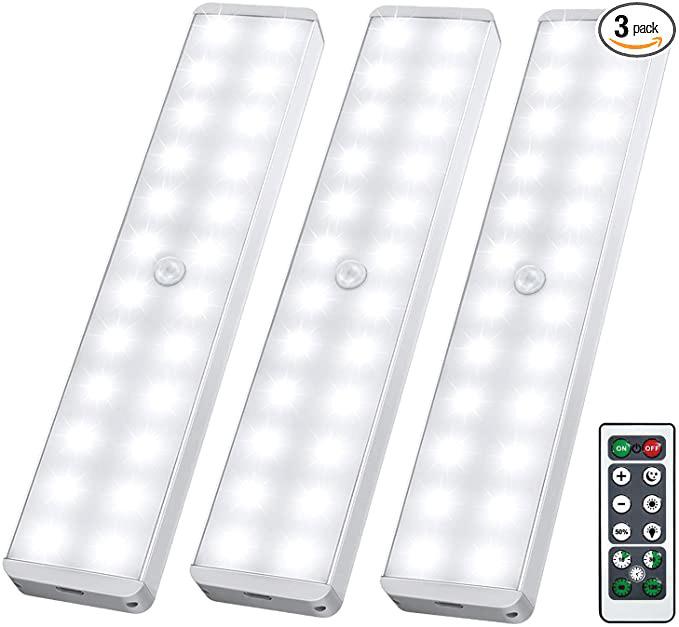
Update the look of your floors with this vinyl that can be ordered with or without glue. RecPro's vinyl RV flooring gives the look and feel of wood to cozy up your space.
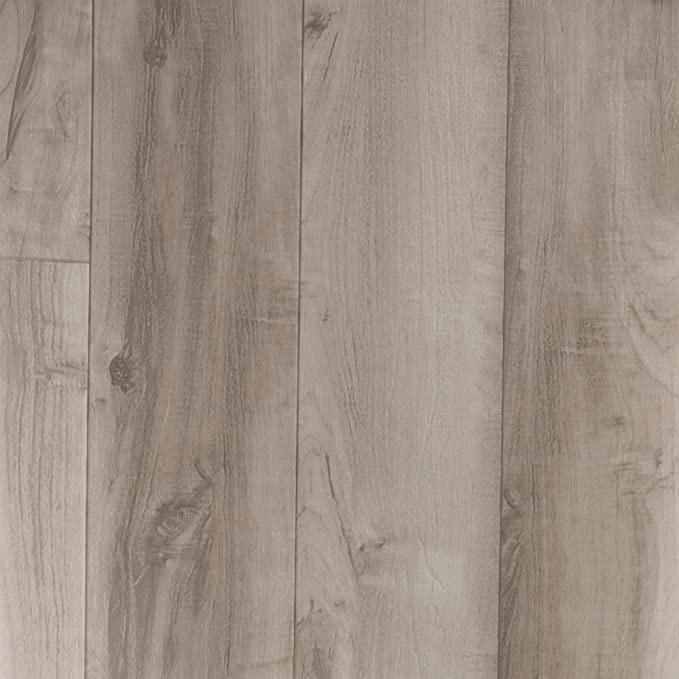

The right gear helps you get the job done safely and easily. Protect your eyes during your renovation projects with these anti-fog, anti-scratch safety glasses.
Have a product you love and want to share? Tell us about it! Email collab@rootlessliving.com for a chance to have your product review featured in an upcoming issue.

A podcast that connects and unites people from all walks of life to learn about shared experiences through thoughtful dialogue and organic hilarity.

A true crime, creepy history, and all things spooky podcast hosted by an autopsy technician and a hairstylist. Join us for a heavy dose of research with a dash of comedy thrown in for flavor.

Meaningful conversations with authors, athletes, musicians, speakers, and film and television stars in search of the answer to one question: What is the best advice you have ever been given?

Feminism, race, writing, art, pop culture, food, politics, and more. If you enjoy hearing from people—black women, usually—who bring unique perspectives to a world in chaos, put this show on your agenda.
Lifelong fans of true crime stories, Karen Kilgariff and Georgia Hardstark tell each other their favorite tales of murder and hear hometown crime stories from friends and fans.


After meeting in a residential eating disorder (ED) program, Lauren and Georgia share ED stories while continuing to recover themselves. This is a feel-good inside look at how recovery can be fun, raw, and vulnerable.

Everyone needs a little help being a human. From sleep to saving money to parenting and more, we talk to the experts to get the best advice. Life Kit is here to help you get it together.

Humans are resilient. In tough moments, we will fight, struggle, and triumph … often against the odds.
Feel as though you’re living these experiences with our heroes as they push themselves to their limits.
Podcasts are listed as a courtesy to our readers and compiled from recommendations in various social groups. If you have a podcast you think we should include, email us at collab@rootlessliving.com.
Our Service Response Team consists of eight expert techs with trucks and trailers spread out across the US. They are committed to training dealer technicians to aid in getting you in and out of appointments. The team is trained to assist anyone stuck on the side of the road in need. You don't have to be a part of the Grand Design Family to receive our helping hand. In times like these, we need to show all RV'ers that Grand Design cares about them even if they didn't choose our products as their home away from home.
